Disclaimer: This post contains affiliate links to handpicked partners, including tours, gear and booking sites. If you click through or buy something via one of them, I may receive a small commission. This is at no extra cost to you and allows this site to keep running.
This guide to travel in North Korea talks about tourism in this very restricted country and what it is really like to visit the DPRK.
Travelling to North Korea for seven days was hard. It’s propaganda via the medium of travel. I was overwhelmed, confused, upset, surprised, and returned with more questions than I had before I went.
My perceptions were certainly challenged while visiting the Democratic People’s Republic of Korea (DPRK). Living in the western world means I have always been exposed to a one-sided and exaggerated view of what goes on there. A biased view that never mentions anything positive and masks any forms of progress that might just pave the way for a better future, even if it evolves slowly from an extreme belief system.
At the same time, any showcased achievements you see when there entirely mask the atrocities that we know about but are obviously not mentioned.
North Korea is a country held high as the ultimate war trophy, whose unpardonable extreme ideological policies are mocked alongside the suffering of its people, rather than put into context and explained. Yet interaction with North Koreans, however limited, paves a way for understanding. The more we learn, the less inclined we are to make assumptions. Travelling can help provide that context.
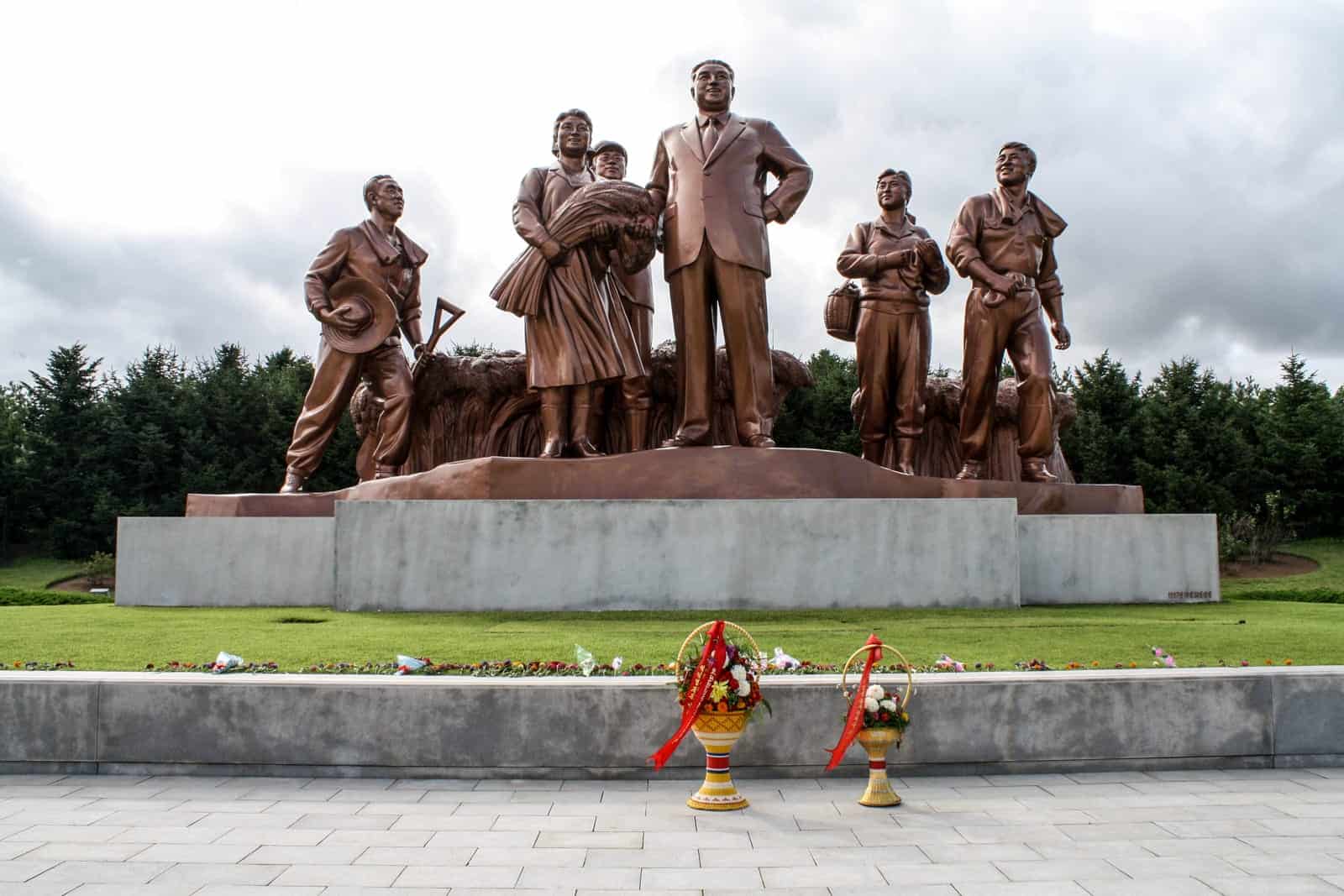
North Korea Travel Guide – The Reality of a Visit to the Hermit Kingdom.
Contents
- North Korea Travel Guide – Frequently Asked Questions
- Can Anyone Travel to North Korea?
- Are Americans Allowed to Travel to North Korea?
- How Can I Travel in North Korea? DPRK Tours
- Do you get a stamp in your passport when you visit North Korea?
- How Do I Get Into North Korea?
- Is it Safe to Travel to North Korea?
- What are the Tourism Rules for North Korea? 10 Things to Know
- My North Korea Experience
- Real Life in North Korea – A Brief Look from the Bus Window
- Are People Brainwashed in North Korea?
- Is it Ethical to Visit North Korea?
- What Do You Get to See in North Korea?
- Be Open-Minded When You Travel Here
- The Importance of Travelling to South Korea
North Korea Travel Guide – Frequently Asked Questions
Can Anyone Travel to North Korea?
You can’t travel to North Korea unless you are in a guided tour group. Tourism in North Korea is very restricted and you almost feel as though you live on the tour bus as you can’t wander around freely. At all times, you have two guides who chaperone you every step of the way.
It’s a completely different way of travelling, and as held back as you feel, the local people simply are not used to western faces and so this form of control allows them a slow introduction. When you visit North Korea, it is not a holiday.
South Koreans are not permitted entry to North Korea.
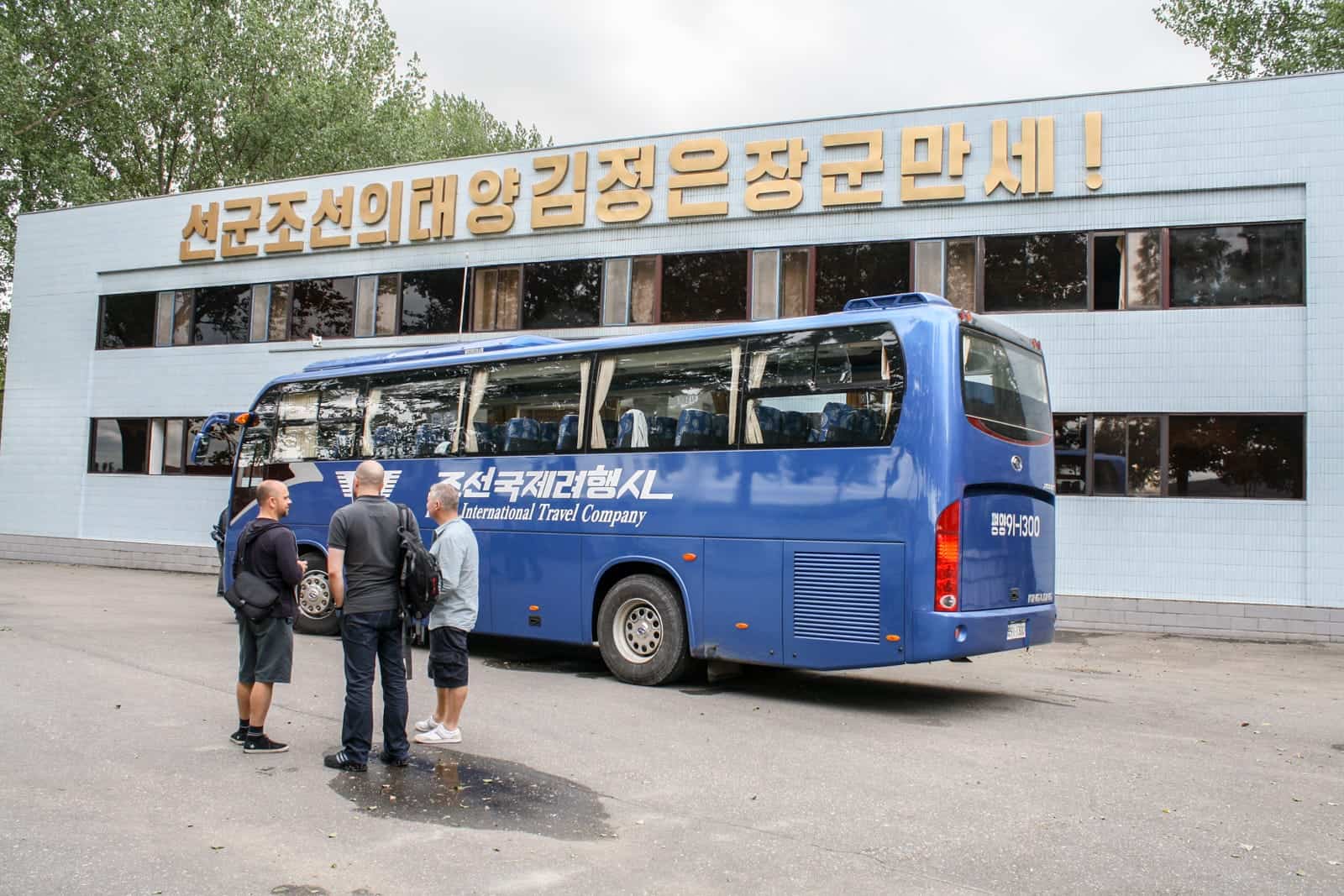
North Korea travel is all about spending most of your time on the bus.
Are Americans Allowed to Travel to North Korea?
Following the death of American tourist, Otto Warmbier after he was arrested and detained in North Korea, US Secretary of State Rex Tillerson authorised his department to block Americans from traveling to the country, which already advised against travel to North Korea.
The ban came into effect on 1st September 2017, leading some tour companies, such as Young Pioneers no longer taking American tourists into the country (effective as of June 2017). Journalists and humanitarian workers are allowed to apply for exemptions under the ban.
How Can I Travel in North Korea? DPRK Tours
Choosing a North Korea tour isn’t too difficult since there are not an abundance of companies offering travel experiences there. I went with Koryo Tours in 2012, given their great reputation and the fact they opened up the concept of tourism there first.
Not only is it very expensive to go to North Korea, but I wanted my trip to be expertly organised. With the tour starting and ending in Beijing, and all your visa requirements taken care of, the whole process was hassle-free.
The night before I remember sitting with a guy in my Beijing hostel, who was also going, and feeling overwhelmed. “We are going to North Korea! I can’t believe it!” which was quickly followed by “I’m scared”. Really scared of the million rules and regulations we had to adhere to, scared of what we might see, doing something wrong and being in trouble. And scared of what I would end up feeling.
In the departure lounge, nervousness and excitement were expressed through a mutual exchange of our knowledge and opinions. It’s better to get everything out of your system before you are exposed to exaggeration, propaganda, and overshadowed facts where you have to keep a straight face. You will only be shown what they want you to see.
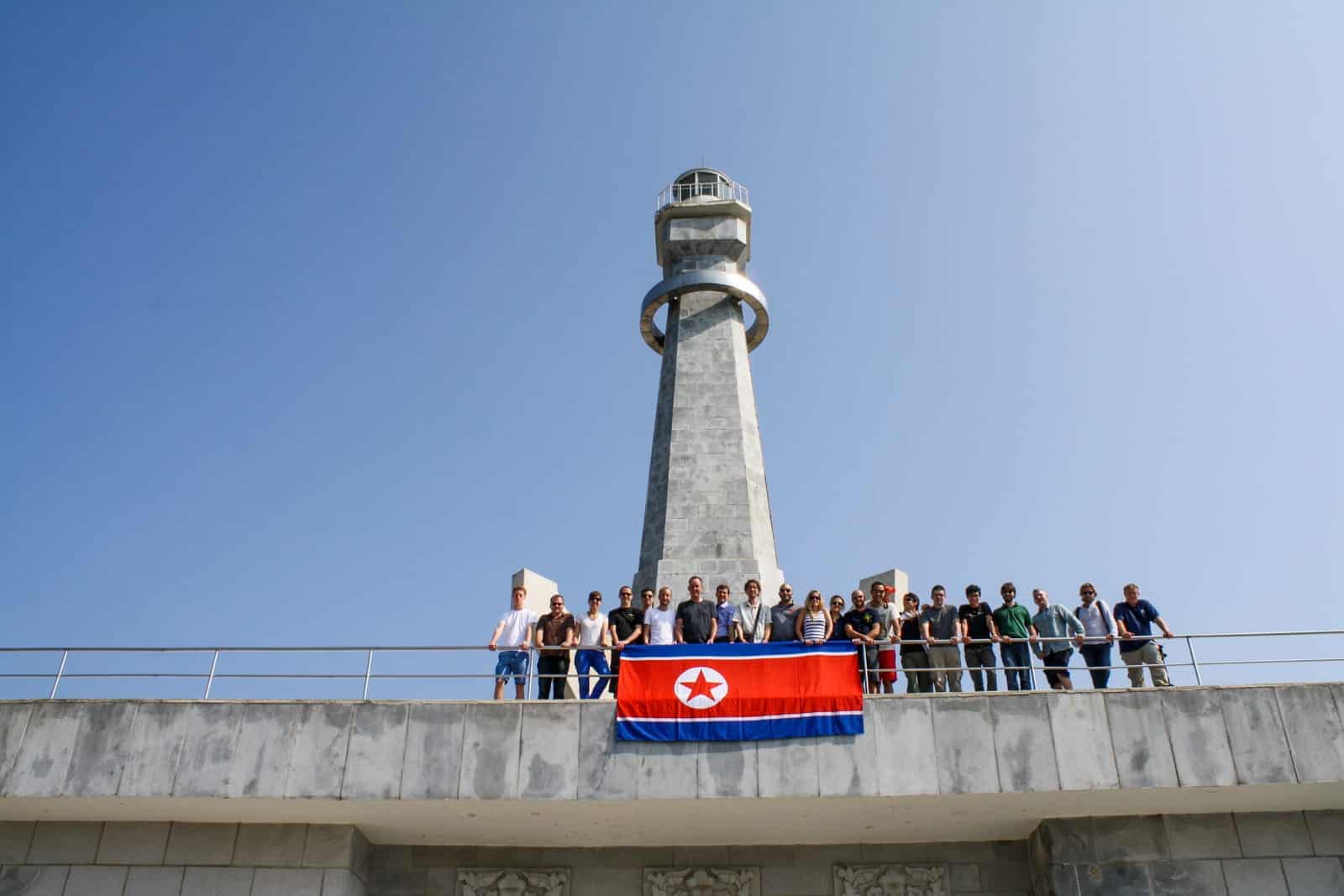
North Korea Koryo tour group.
Do you get a stamp in your passport when you visit North Korea?
No – the visa is simply printed out and kept together in one big file for the entire group which includes individual images of everyone on the tour (a page that is also stuck on the bus window for reference).
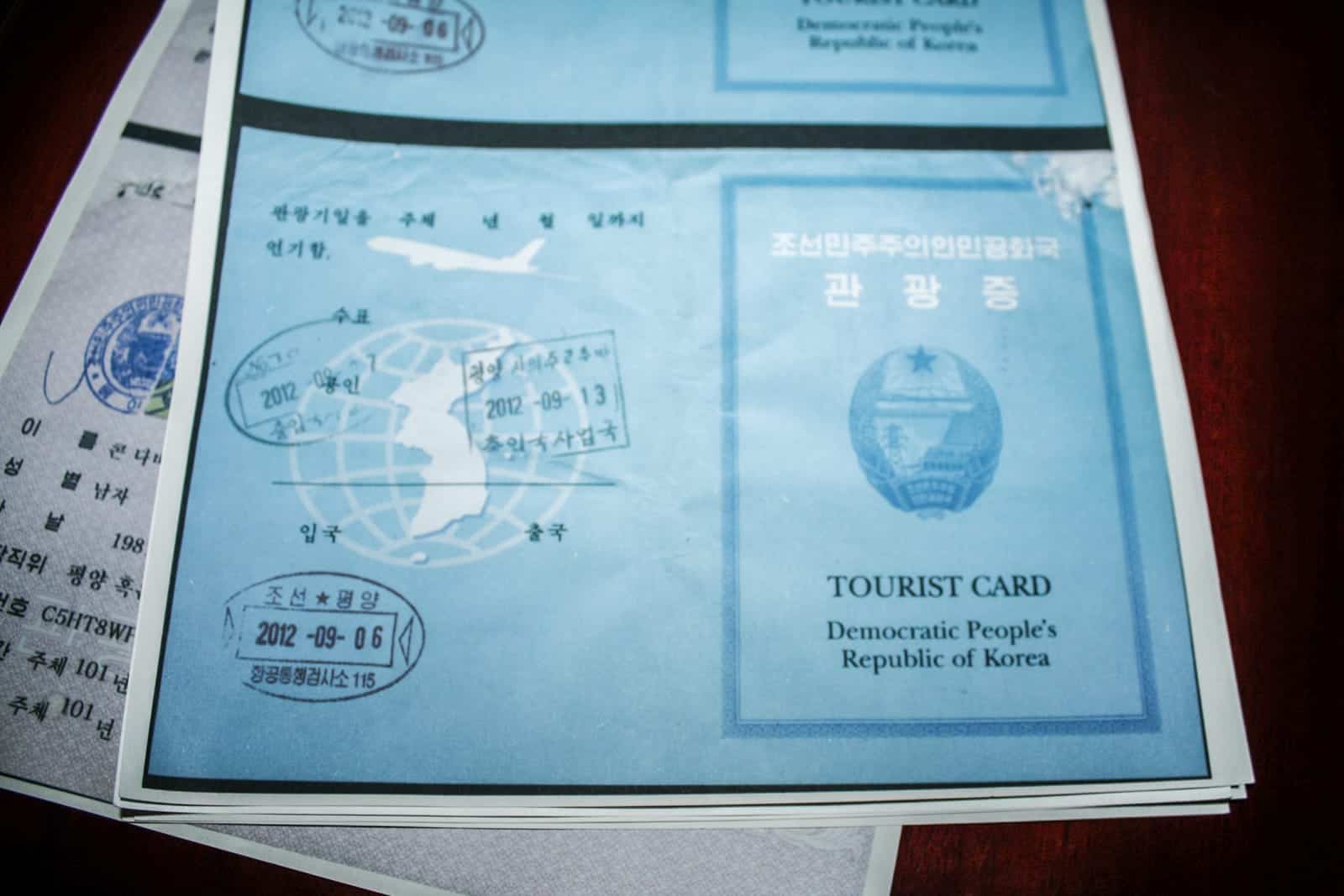
The tourist visa card to North Korea.
How Do I Get Into North Korea?
After signing up for a tour and when your visa and permission for entry to North Korea is granted, you will fly from Beijing to Pyongyang on Air Koryo – a state-run airline. Air Koryo has consistently bad ratings, but flights to North Korea are the only means to enter.
The majority of organised tours leave Pyongyang via train, back to China (specifically Beijing), upon which North Korean guards will enter the train before its entry into China to check your camera and make sure you are not taking any offending material outside of North Korea. Other tours may also fly back to China via Air Koryo.

Boarding the Pyongyang to Beijing train.
Is it Safe to Travel to North Korea?
As long as you follow all the rules outlined to you before you enter North Korea, travel is ‘deemed safe’ in the respect that you are never alone, never allowed to travel at your own will or allowed to travel outside of the designated areas where North Korean guides chaperone you at all times. This means it is highly unlikely that you will be affected by any serious crime or be the victim of it, nor witness any major situation in the country at the time due to the controlled nature of the visit.
North Korea isn’t a communist dictatorship where people and visitors have relative freedom, like Cuba. Every DPRK tour factors in a full briefing, before departure, on every applicable rule you must follow. These are often reiterated on the trip itself. There is no excuse for breaking the rules which are very clearly laid out.
There is nothing brag-worthy about travelling in North Korea; everyone is effectively at risk travelling there.
It is also wise to keep up to date with the latest news agenda, alongside political tensions in the area and those between North Korea and your country of citizenship that may affect your entry to the country as well as any pending bans or rule changes.
What are the Tourism Rules for North Korea? 10 Things to Know
You will attend a meeting in Beijing at the offices of your designated tour company before the start of the tour (normally 24-48 before), which outlines the rules you must adhere to when travelling in North Korea. These include:
- The types of camera and lens size permitted for use in the country.
- How your Passport will be taken from you when you enter North Korea, for the duration of the tour (and usually kept by your tour group leader) and returned to you upon arrival back into China. The reason for this is stated as being “for security reasons”. At the time I travelled, my mobile phone was also confiscated.
- How to take pictures of the Kim statues, which cannot be captured close up or cropped. They must be captured in their entirety.
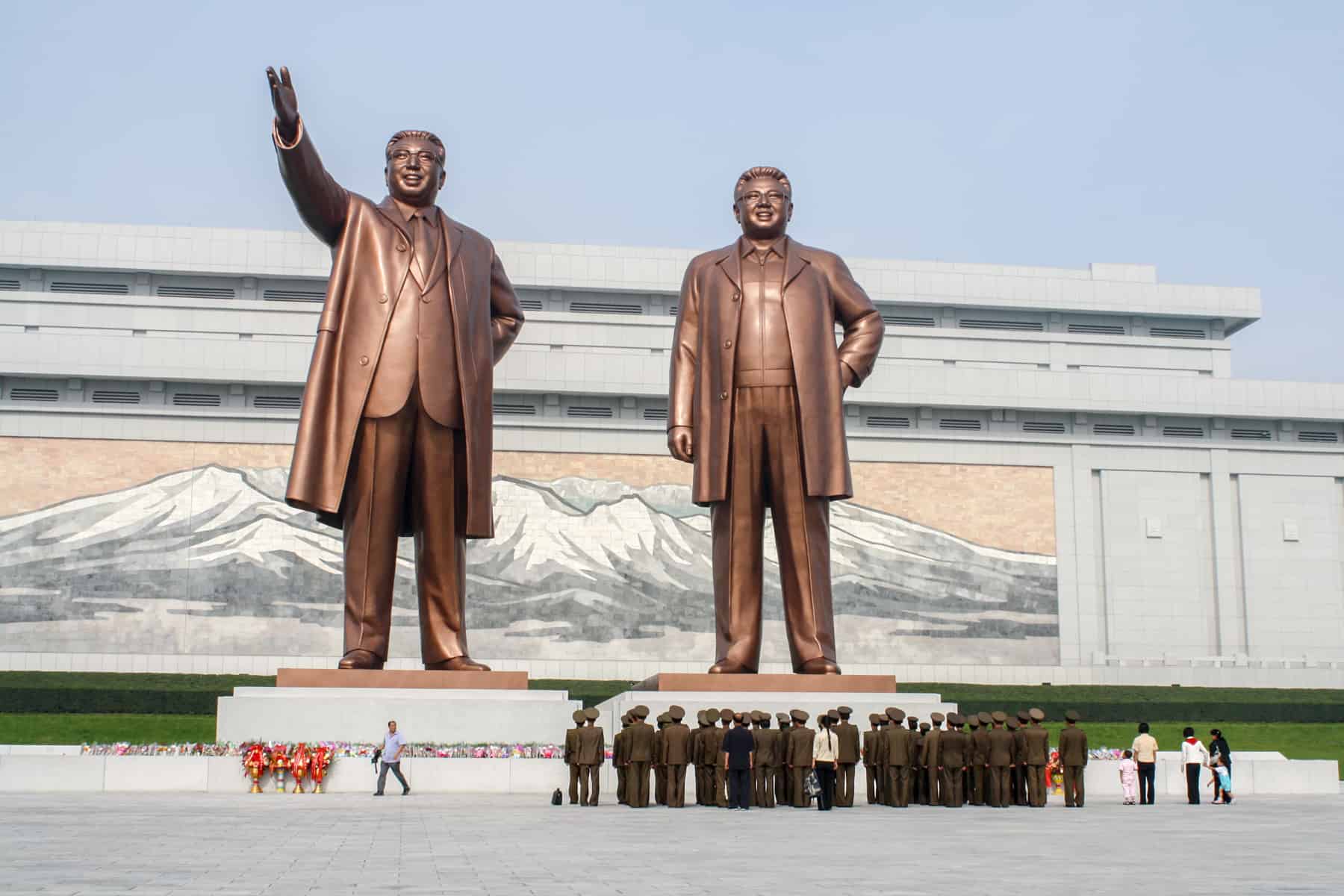
Bronze statues of the Kims in North Korea.
- The kinds of pictures you are NOT allowed to take. Pictures of any form of construction, scenes that denote poverty and images of the military are not permitted. When in doubt about the nature of what can and can’t be photographed, ask first.
- How you will be expected to honour the leader. When visiting the statues of Kim Il Sung your group will be expected to bow and lay flowers, just as the North Koreans do. You are also obliged to pay respect when visiting all monuments of national importance.
- The importance that any kind of independent travel in North Korea is in no way allowed, anywhere or at any point of the tour.
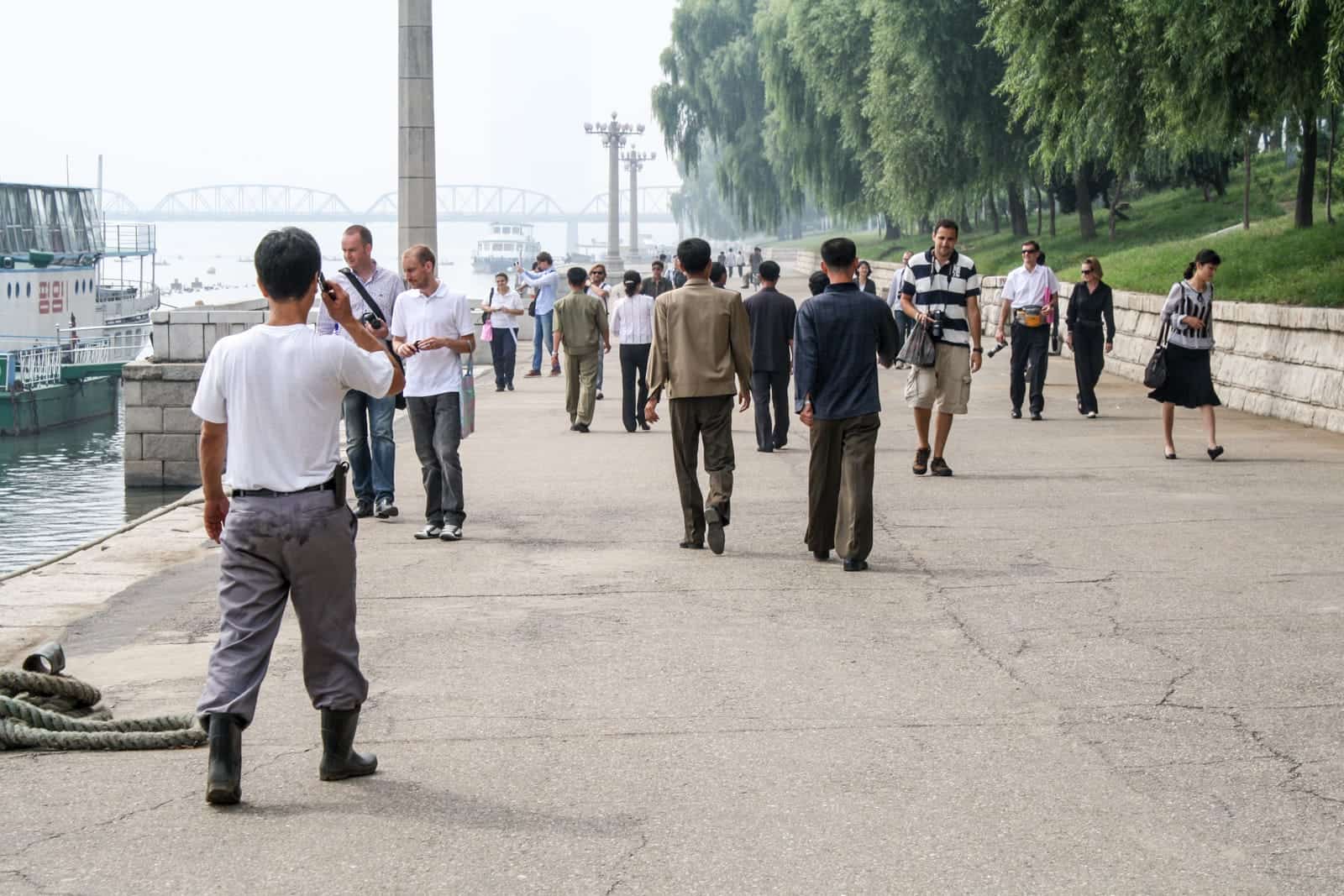
Pyongyang city seafront.
- Do not try to reason, state facts, change the narrative or attempt to overturn the words and actions of your North Korean guide or those you come across at designated sites. This is their job, and while you might categorically know something not to be true, they have no choice, and you chose to be in this restricted and propaganda-heavy situation.
- Any attempt to converse privately with a North Korean citizen will be seen as an act of espionage.
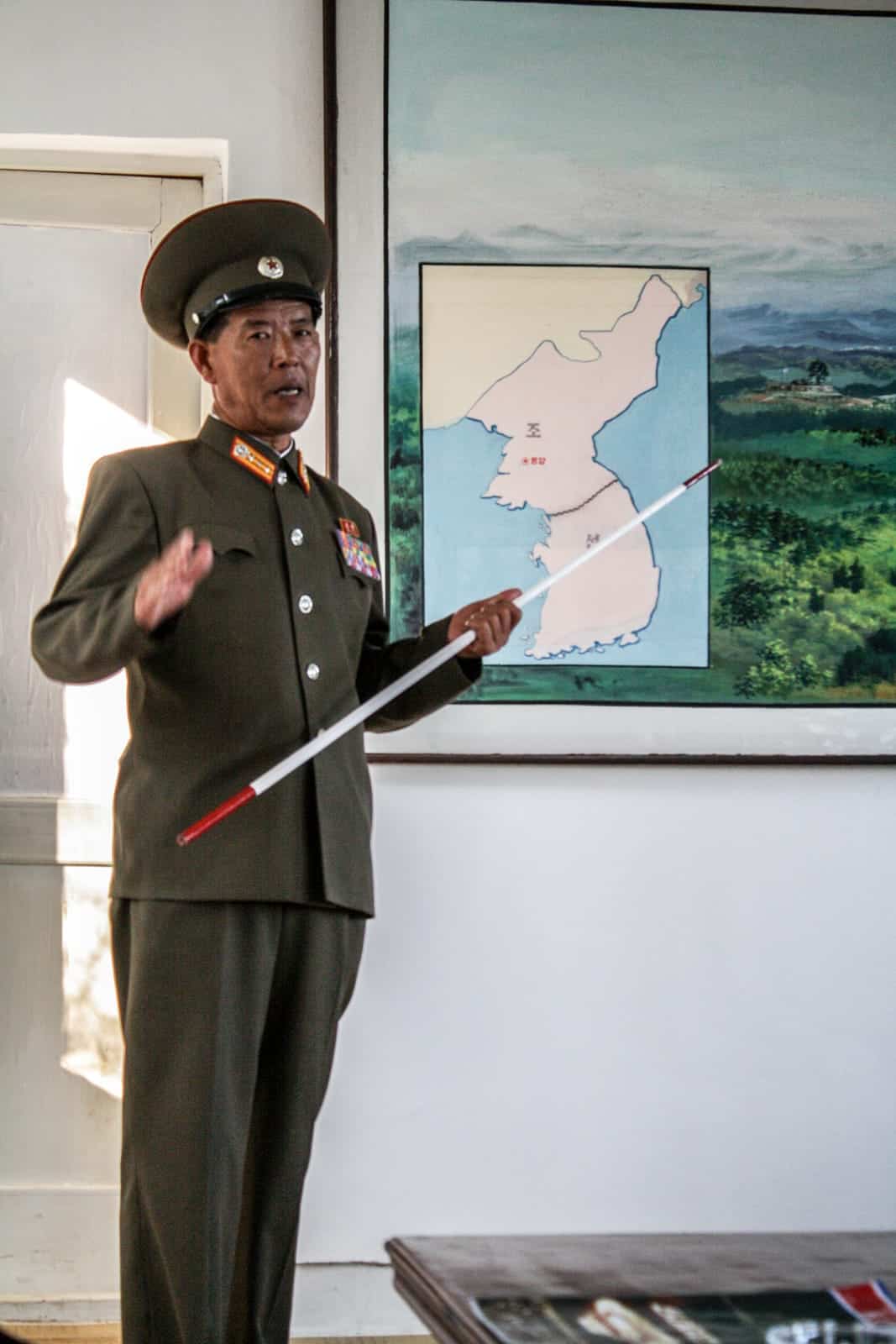
North Korea guard explains the history to tourists visiting the border with South Korea.
- To act positive, praise-worthy and keep any negative thoughts to yourself and not say anything derogatory out loud. It’s better to be submissive and accept the situation than to be seen as trying to overturn it.
- Do not bring with you any materials pertaining to South Korea, religion or anything that can be seen as a form of ideology of which you will be seen as imposing.
You must absolutely follow the rules for travel in North Korea and don’t do anything outside of those rules which may draw attention to yourself.
There are no exceptions to these rules and nor will you get off lightly. Imprisonment and torture are common forms of punishment and your tour company has no special command to get you off the hook.
Also, anything you do wrong also puts your North Korean’s life (and their family’s lives) at risk.
My North Korea Experience
When You Visit North Korea Your Initial Perceptions are Challenged
Pyongyang, where the North Korea tour is mostly be based, isn’t a grim and frightening ghost town. Looking out from the top of the hotel, you are afforded a view just like any other big city, including skyscrapers, factories, monuments and mass housing. It is, after all, the centre of the country’s most elite – it exists as a centrepiece and to house particular people.
I thought Pyongyang would be a small concrete city, hidden from view. Instead, it sprawls for miles and miles and looks just like any other city, except it’s scattered with propaganda posters, mosaics and bronze sculptures of the Kims. It is both the pivotal destination for tourism, the capital and at the heart of the regime.
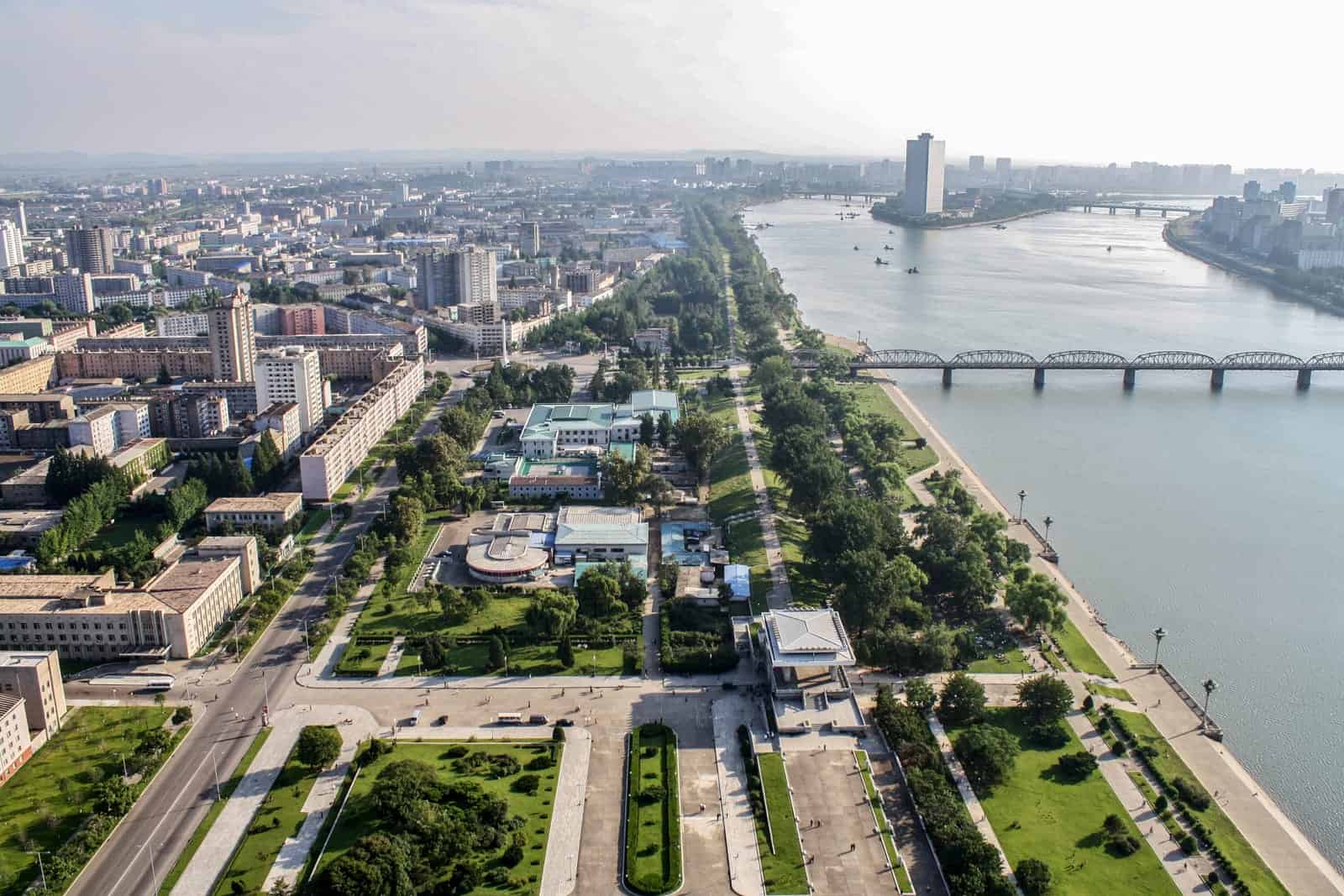
View of Pyongyang from the tourist hotel.
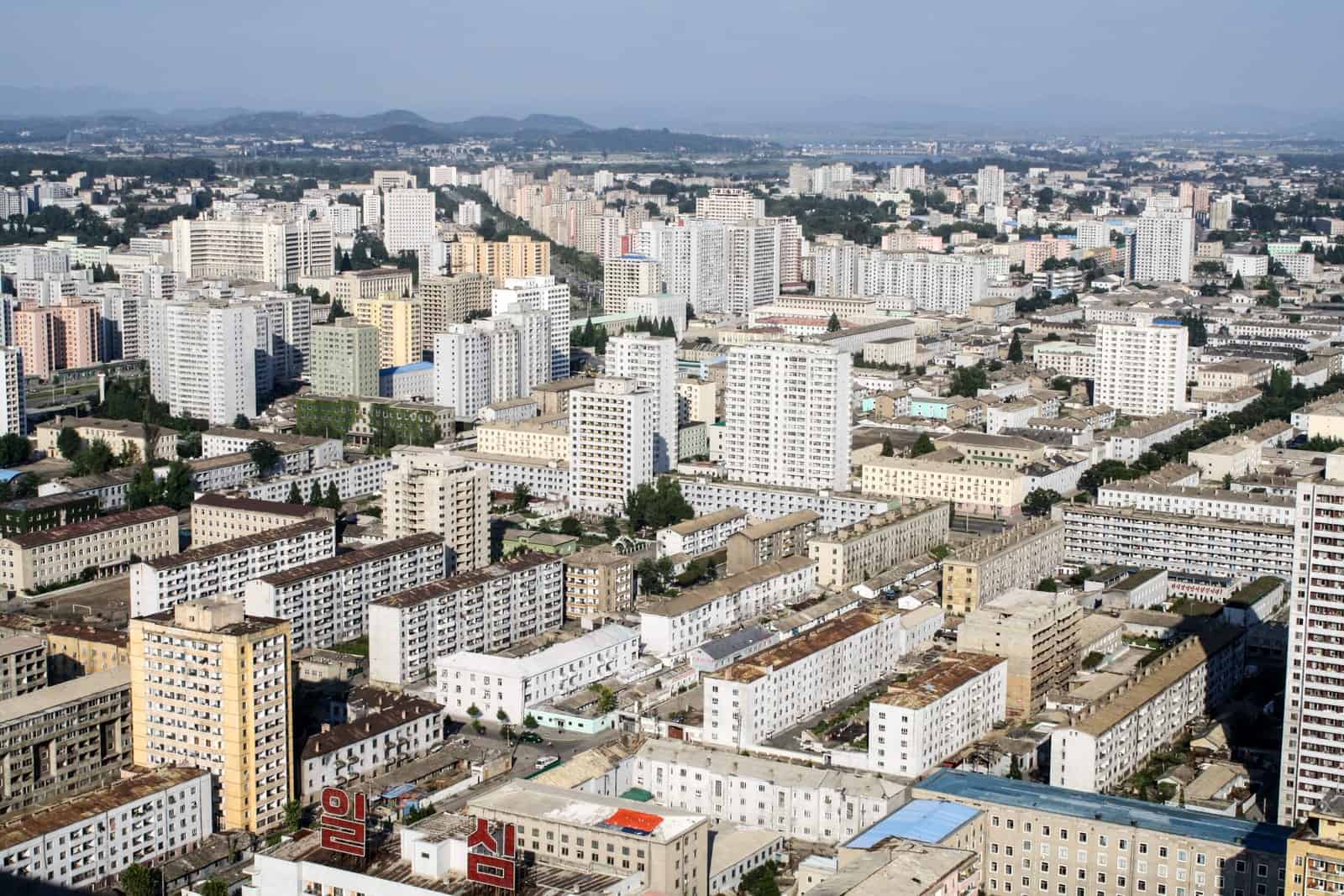
The high-rise buildings of Pyongyang, the capital of North Korea.
There is no denying that it is for show. This is not how the majority of North Koreans live. The city gleamed with new and pristine buildings, built to the grand imposing communist-style façade of dominance, modern progression and increasing wealth.
There are statues so immense that their towering presence automatically creates an air of intensity, like the artistic propaganda posters you can’t miss – a style I had previously learnt about at the Shanghai Propaganda Poster Art Centre prevalent during the Mao’s Communist Regime in China. The stylised shop fronts we too often take for granted when at home are, in fact, empty. Or they happened “to be closed” that day, of course.
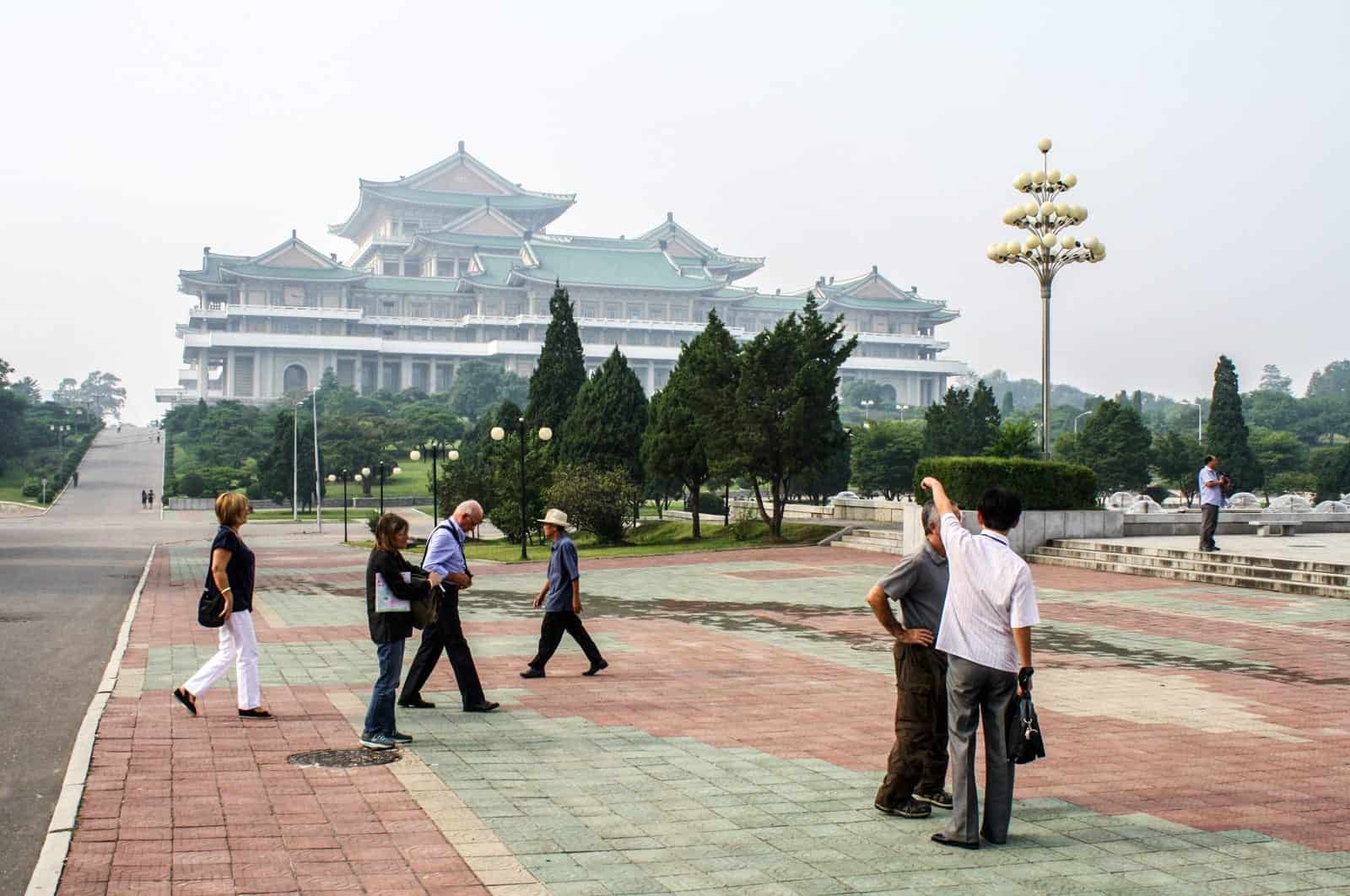
Sightseeing in Pyongyang.
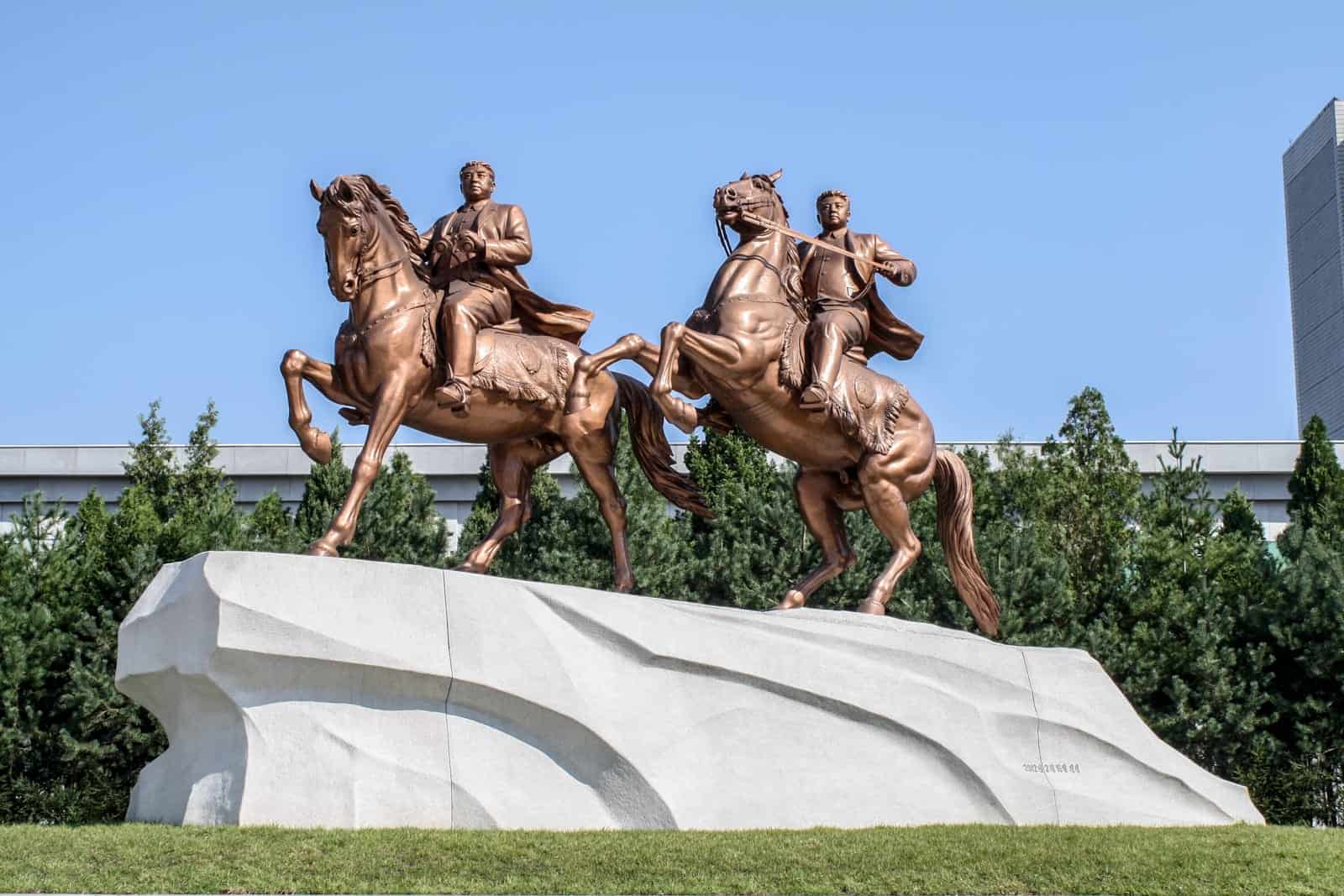
Bronze statues of the Kims riding horses.
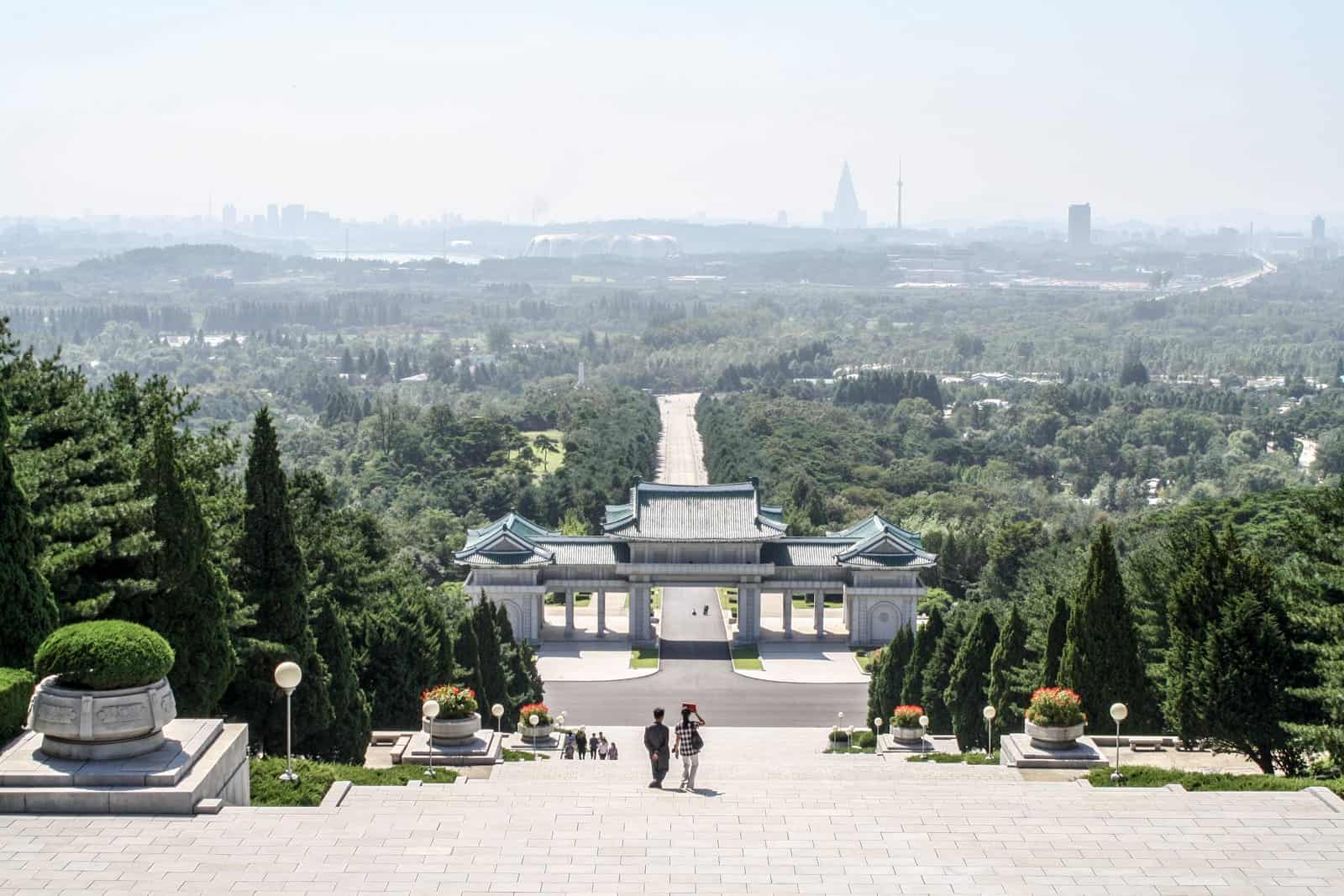
Elevated view of Pyongyang City.
It was, seemingly, a functioning city full of local people going about their daily lives. Whether that was the queue for a building we could only assume is a food and ration station (there are only tourist stores open), the pockets of people disappearing underground to use the Metro station or walking to the office, or the mothers out with their children, we got only a very, very small glimpse of daily life. Mostly from the bus window.
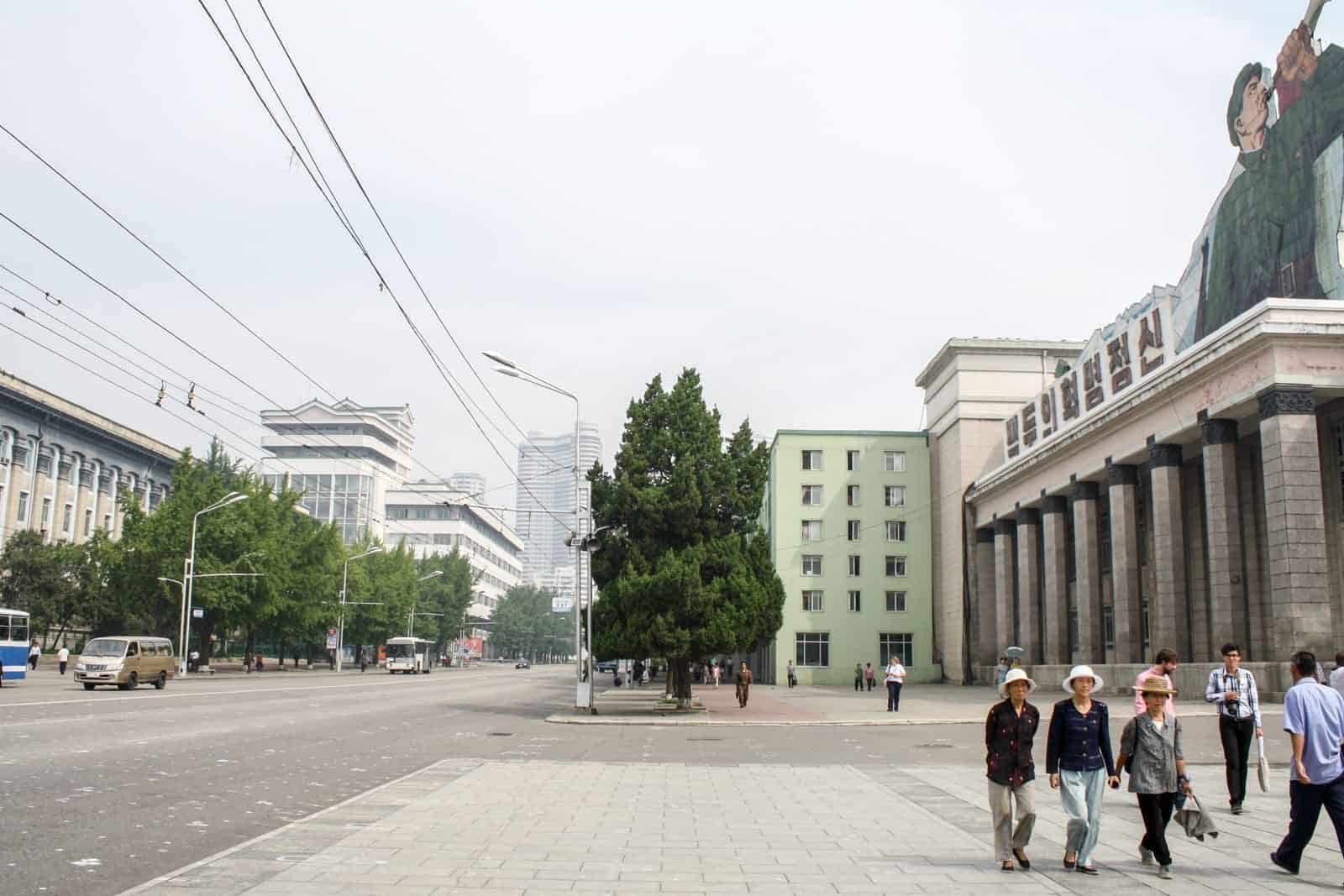
Streets of Pyongyang.

Pyongyang Metro entrance.
You must always remember what is deliberately presented to you when you travel in North Korea.
Whilst you know about malnourishment and mass electricity blackouts, you don’t see it in the show city. So whilst there’s no denying the existence of this because there’s proof from defectors and undercover reporters, in Pyongyang it is not on the scale we are told about because the set-up is very different. Although extreme poverty does exist en masse throughout the country (as footage shows), this is what you (strategically) won’t see.
Real Life in North Korea – A Brief Look from the Bus Window
When we drove out of the city, we did pass shanty-type, less affluent towns. This was a real glimpse into how some of the population live outside of the capital and was the more shocking side to travel here. Of course, upon leaving Pyongyang, you can’t take images. Instead, you only remember what you saw.
Construction was taking place everywhere, and we still wondered why many people were living in semi-completed buildings. I’ve also seen similar neighbourhoods in China and other parts of Asia, where buildings are left rather than being maintained and where wealth distribution is unbalanced. I wouldn’t say this housing is unique to North Korea, but it did show the existence of the same underbelly of poverty. From news investigations, we know deep down it’s far worse than what we see from a quick glance out of a bus window, of course.
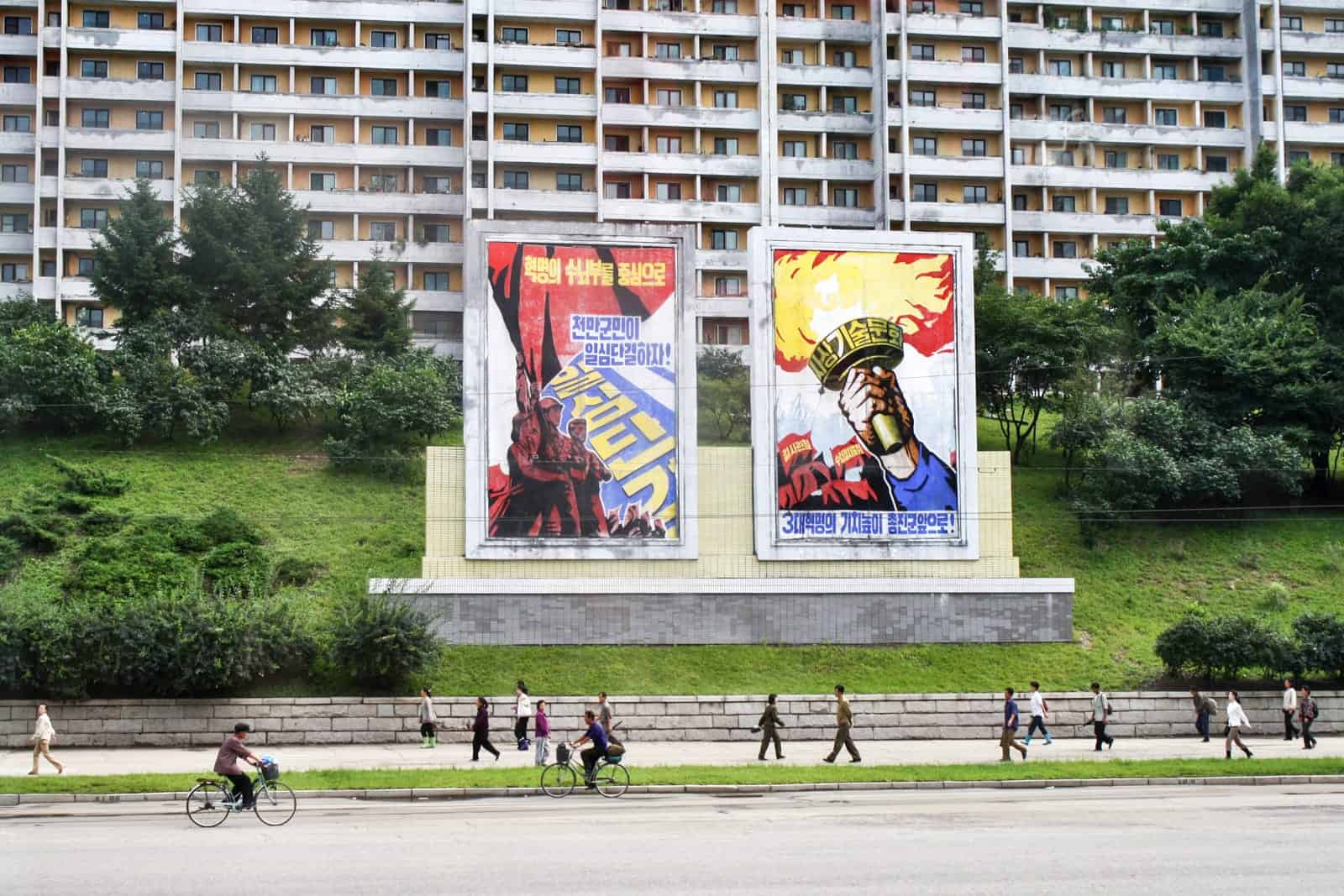
Streets of Pyongyang.
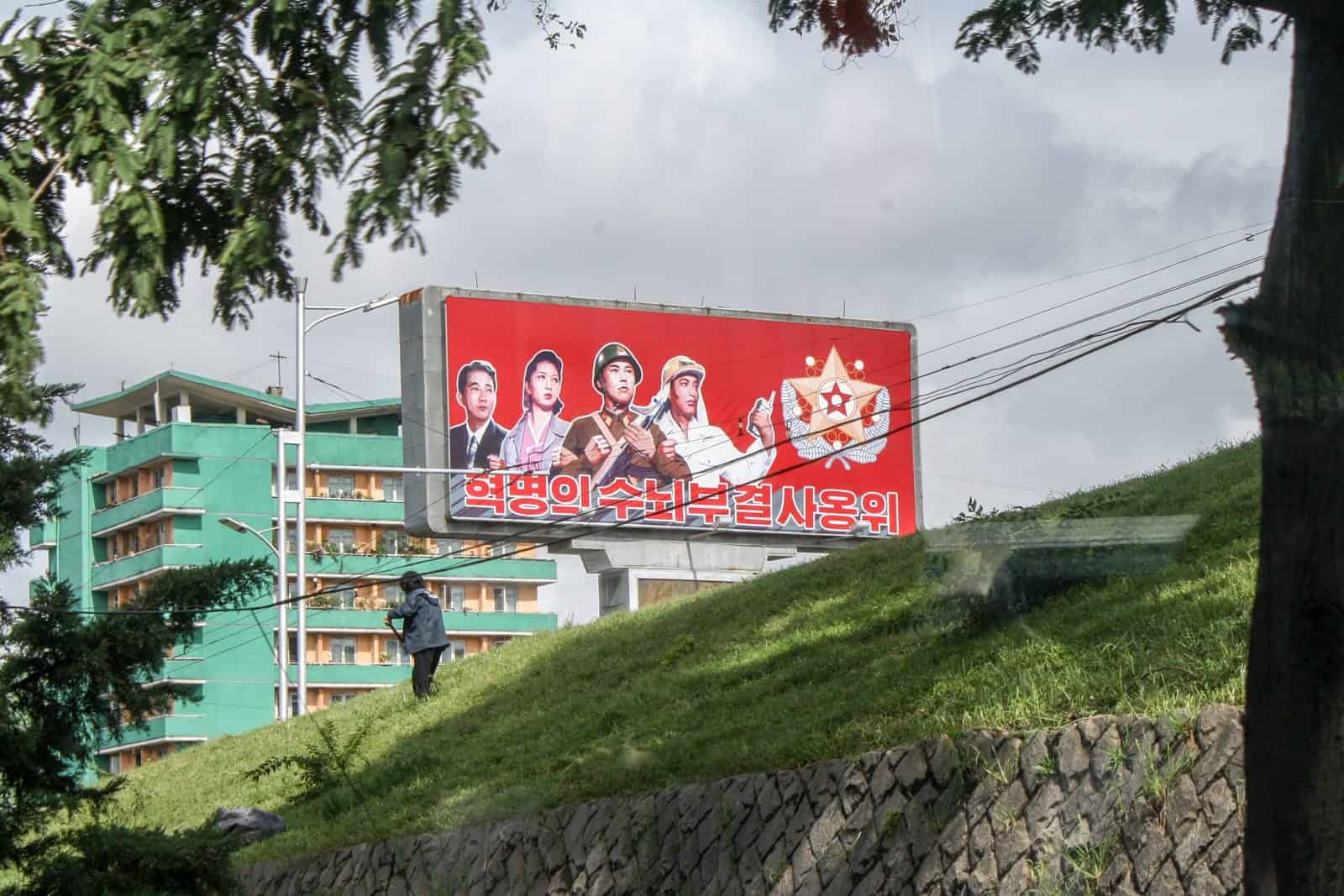
DPRK Propaganda sign in a neighbourhood in Pyongyang.
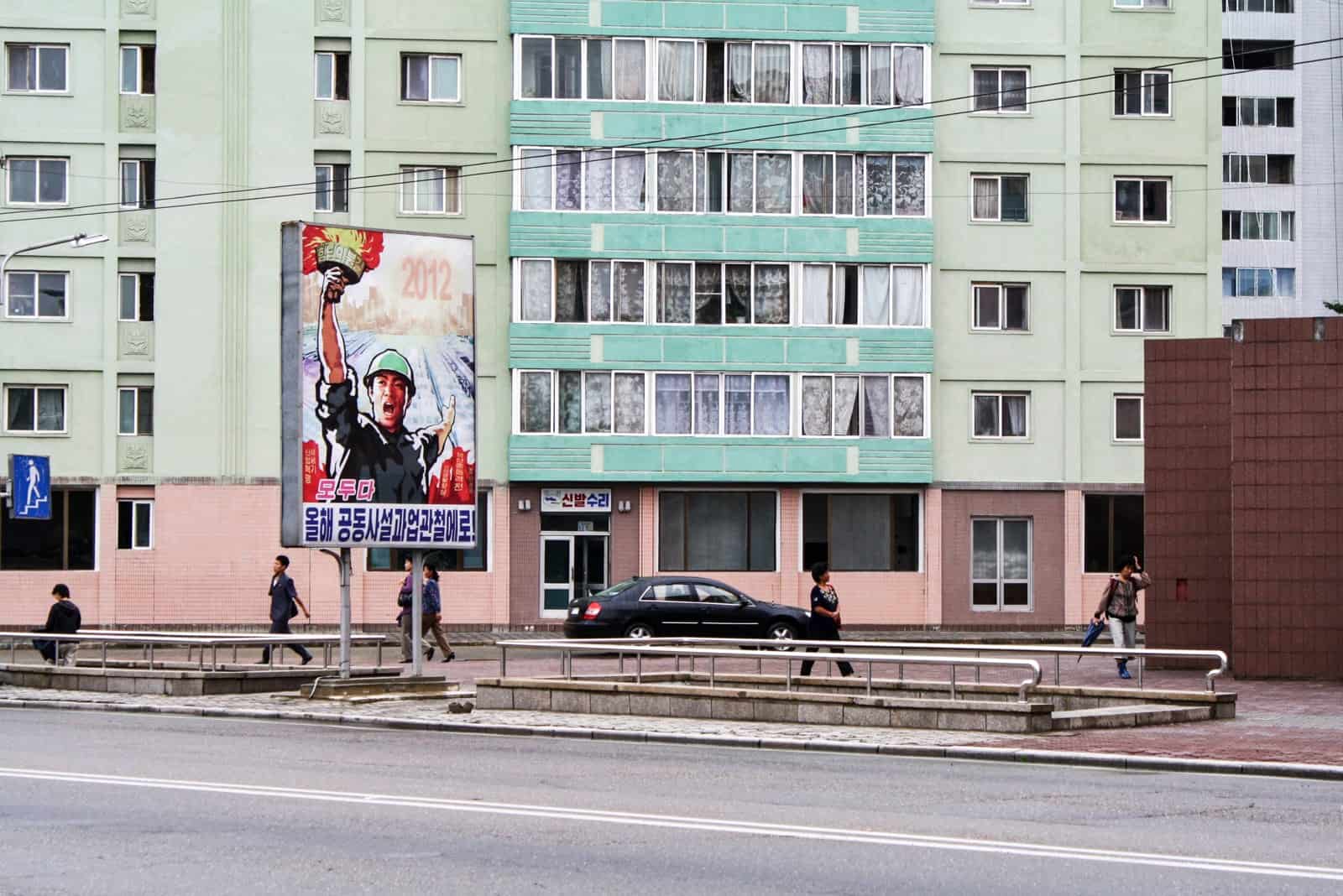
Life in Pyongyang.
What confused me the most about North Korea was the beautiful countryside in Nampo and around – green hills and yellow crop plantations, trees and orchards. In a land that has around 70% mountainous terrain, it looked pretty impressive.
Our British guide told us that North Korea had admitted to bad farming practices and that it lacked knowledge about beneficial methods, but it looked as though things were improving. Or could. If it was put into practice for the benefit of the people.
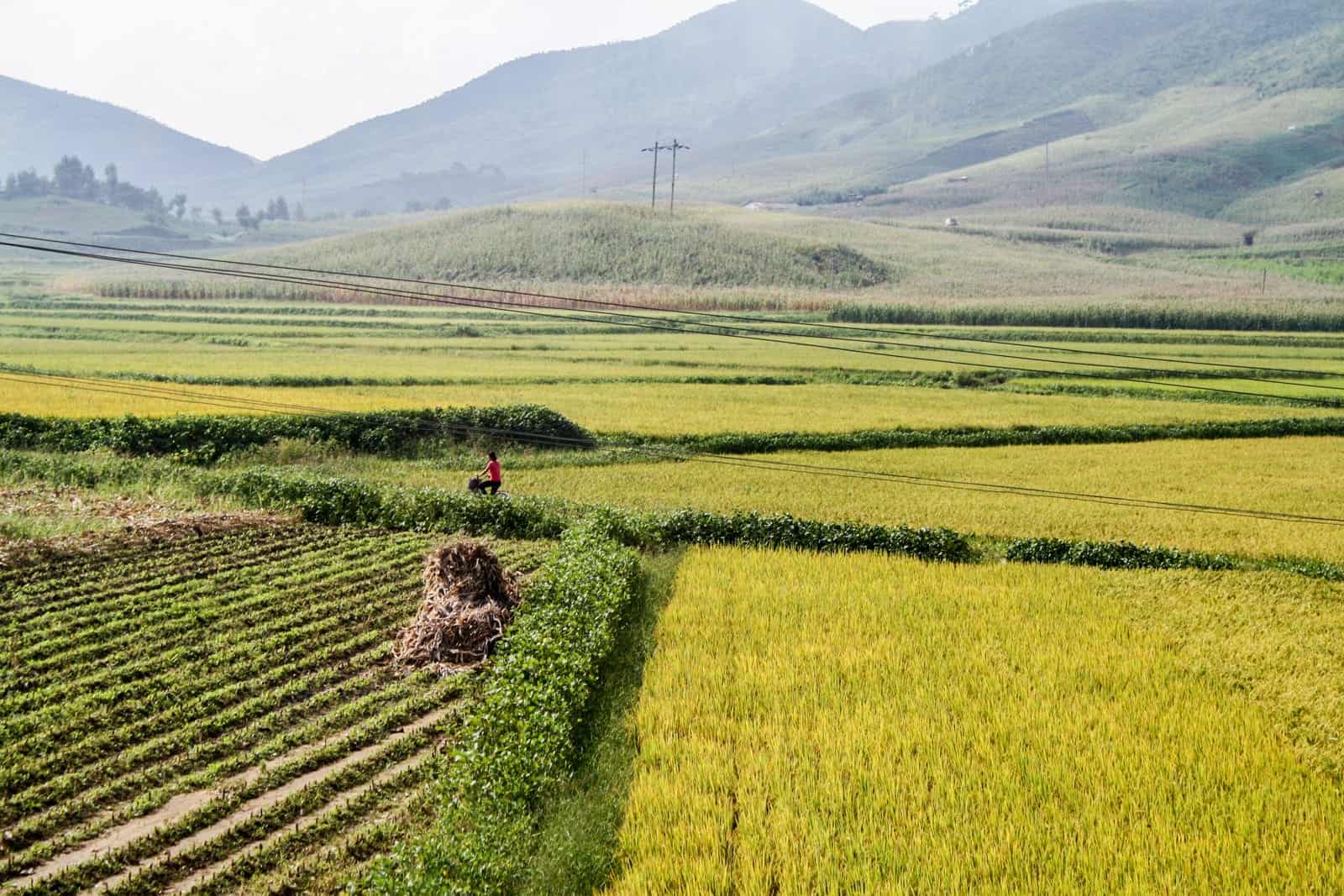
The countryside of North Korea.
I’m no farmer, but I wasn’t expecting to see so much green and grain. Whilst this may not produce a plentiful supply for the entire population, there is production in farming, although I have no doubt that it’s far from enough or distributed properly, if at all. There have been famines since the 1970s when the help from the Soviets ended, and the need for international aid began.

The countryside near Nampo outside of Pyongyang.
Our visit to a local farm was very set up, and we had no belief that anyone we met actually lived there. The shame is that it still provides a window of hope for what can actually be.
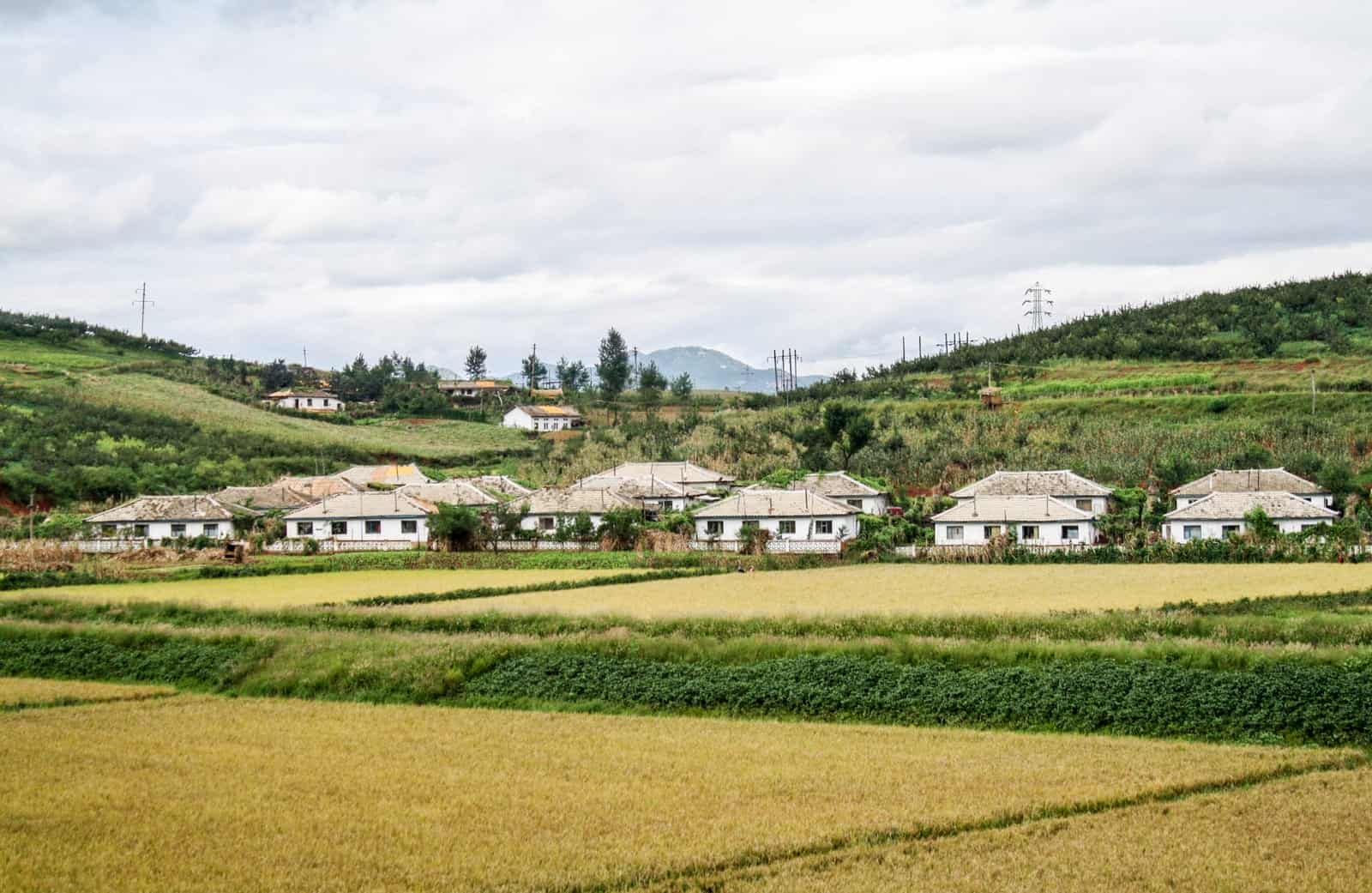
A working farm in North Korea.
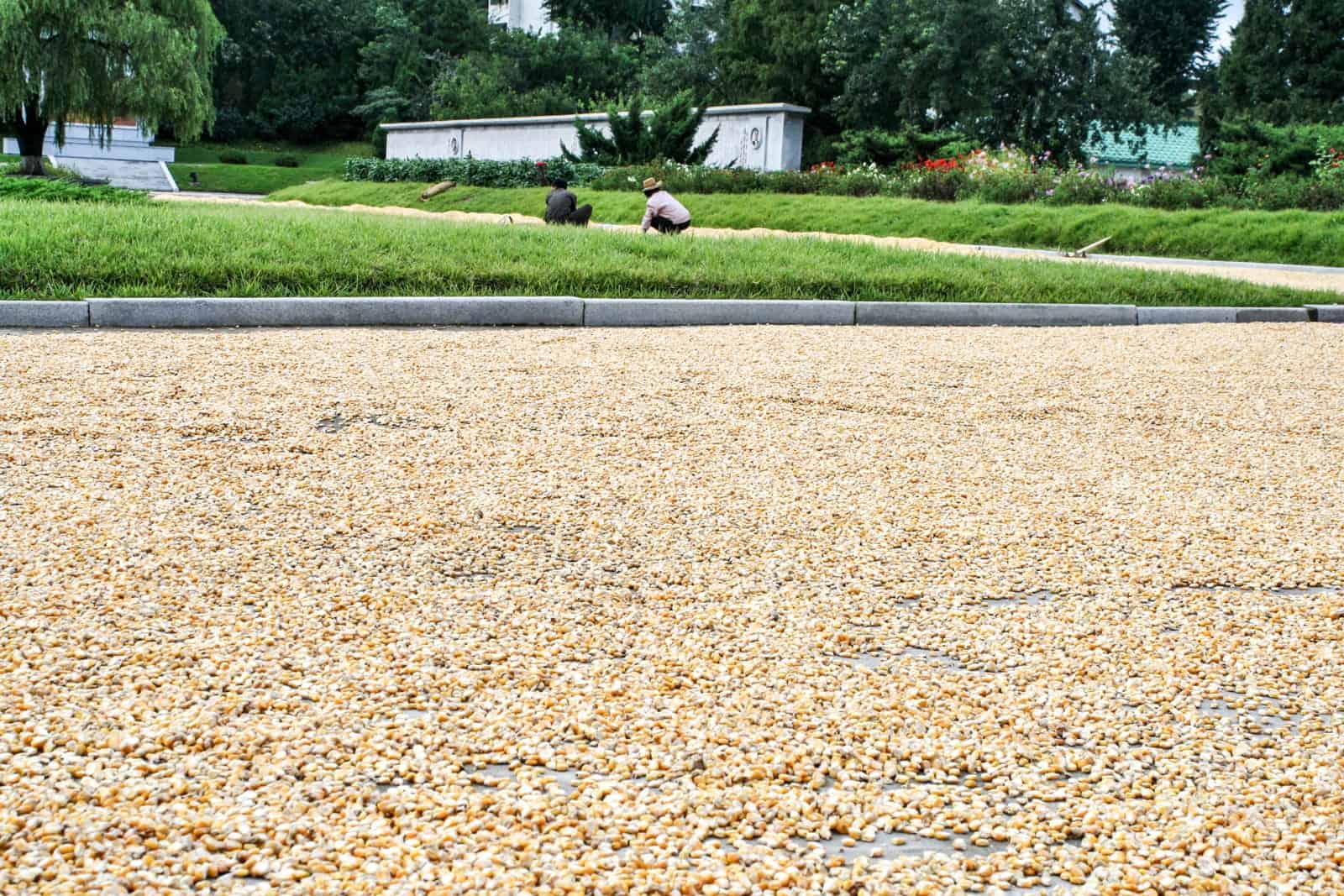
Farming in North Korea.
Our visit to an apple factory with its investment of millions of pounds worth of equipment looked as though a slow growth of manufacture and export is on the cards – or again, one could hope. The mechanism is there – it just needs to be implemented.
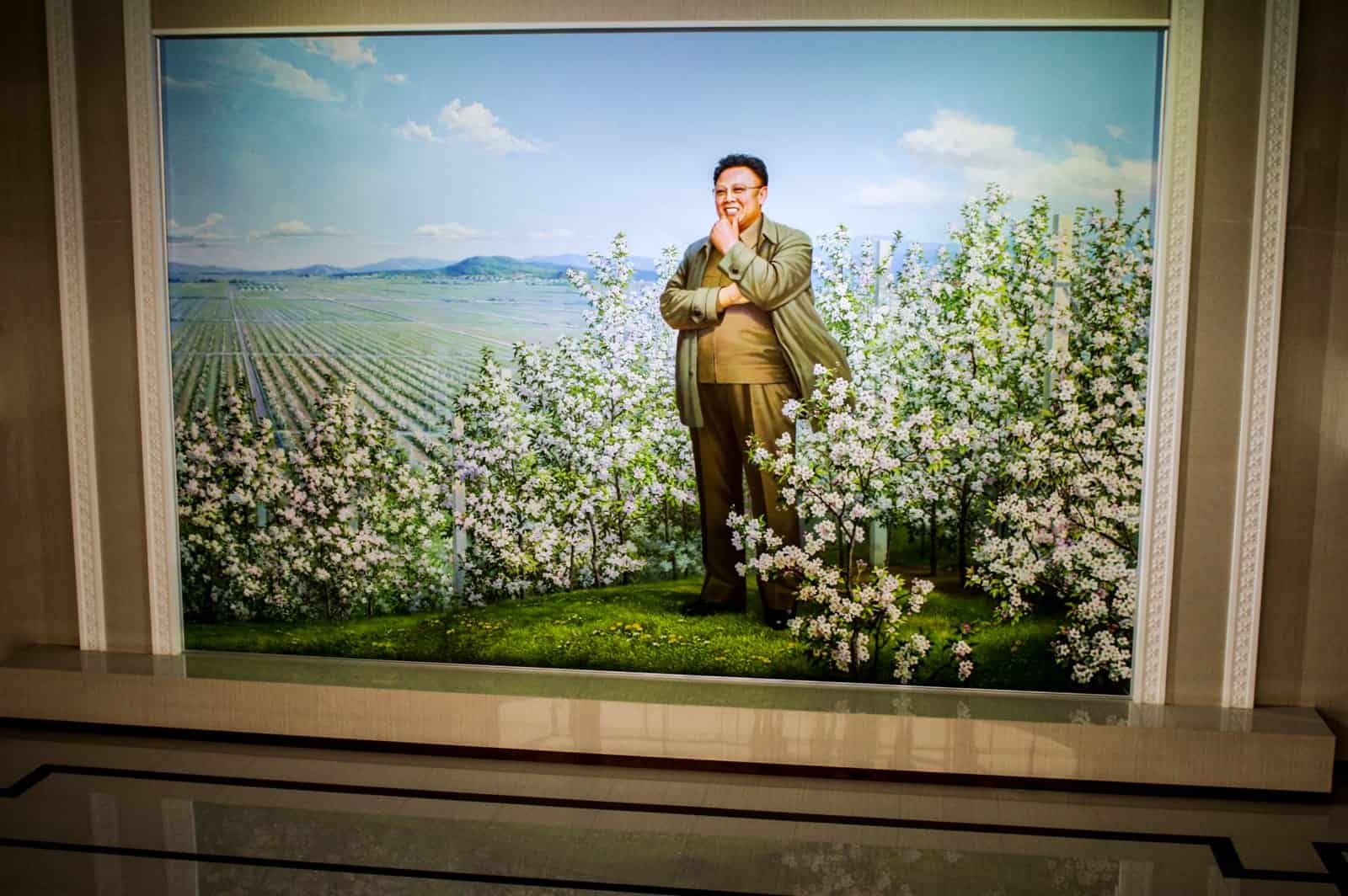
A mural of King Jong Il adorns the apple factory near Pyongyang.

Apple factory tour.
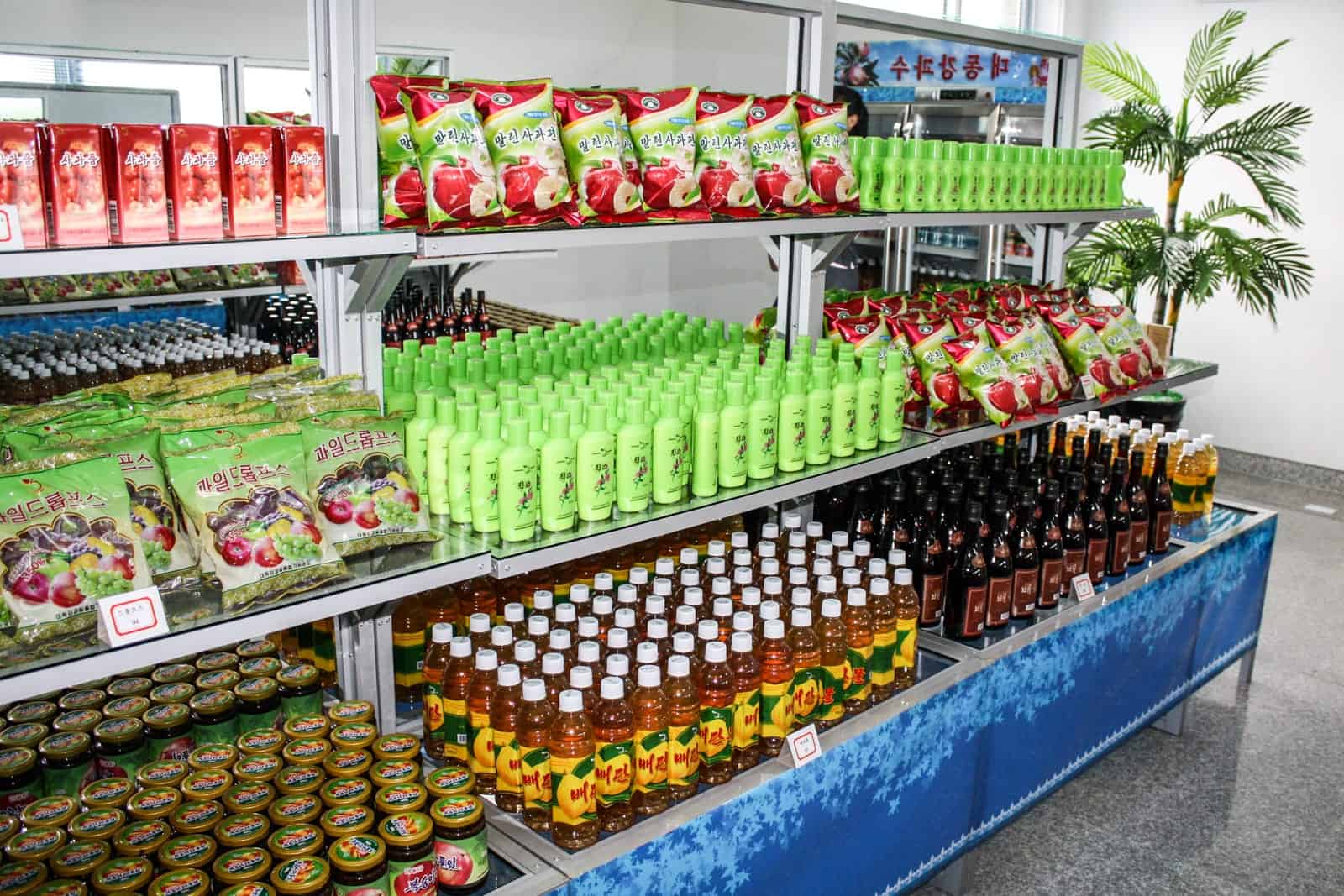
Apple products from the factory are on sale for tourists.
Are People Brainwashed in North Korea?
The question of what it is like to live in North Korea fascinates everybody. When you look into it a bit more deeply, we all are cut from an ideology of the society we are brought up in, except that in North Korea, it is on a very extreme scale to what we will ever know.
From what I observed when I was in North Korea and what I read before and after my visit, the majority of North Korean people know of nothing else, and by having no access to other sources or information and, therefore, no comparison (except the few who retain and obtain information and later defect), it appears they live in a world they assume is normal.
From that sense of normal appears to be a genuine love for the Kims – nearly everybody wears a pin badge bearing one or both of them, and many bow to the statues before work in the morning. They believe in everything they have been told as they have never known the full facts, or been given the means to find out or make a personal judgement. If you knew of nothing else, what would you do? Sure, there must be people from older generations who also know the absolute truth but have no option but to live in submission.
My point is that we shouldn’t be so quick to judge a nation of people without looking at their ideology in context. It’s devastating that people have to live in such isolation in this day and age. We, in the Western world, are lucky to live in societies where we have freedom of speech, freedom of expression, access to information and means from which to realise our aspirations and make informed choices.
We shouldn’t be so quick to brand a nation of people as odd, weird or crazy when they have no clue and are just going about their normal lives.
The normal they know.
Is it Ethical to Visit North Korea?
The ethical question of visiting North Korea is a tricky one, and I sit on both sides of the fence.
On the one hand, everything that happens in North Korea is wrong. At the same time, in that case, we wouldn’t be travelling to many places. Some argue that by visiting North Korea you are helping to fund the regime or government’s objectives, but this applies to many countries open to tourism. Think of the corrupt governments that still exist in Asia and the Middle East, but you don’t think twice about heading there.
On the other hand, meeting North Koreans is a gateway to openness. The North Koreans we met were kind. Our guides were easy-going, approachable, witty and caring. Of course, you can’t talk openly to them, speak of things at home, or try to inform them of the facts behind the Korean War. This would be against the rules set upon you and at risk to them. Beyond the historical ‘facts’ they had to tell and the rules they had to impose (since they would be in serious trouble over any of our irresponsible actions) they weren’t lifeless robots. They became our friends, just like any other person.
On National Day, we walked through a park where locals were celebrating with their families, laying out a huge picnic, firing up the barbeques, playing music and dancing. Some were unsure of us, giving a stare that suggested a slight fear of the unknown and given what they have probably been told about the Western world and its people, others were welcoming, offering food and pulling us into their dancing circles.
You might question the serendipitous encounter at the time visitors arrived. Even if they were told to be there (which is highly likely), shaking hands, smiling and interacting was the only reassurance we could provide that we are not all bad, and I feel that is a positive start to what could be a slow but positive change in this country.
Travelling to North Korea and a tourism drive could be one way to start opening the cracks.
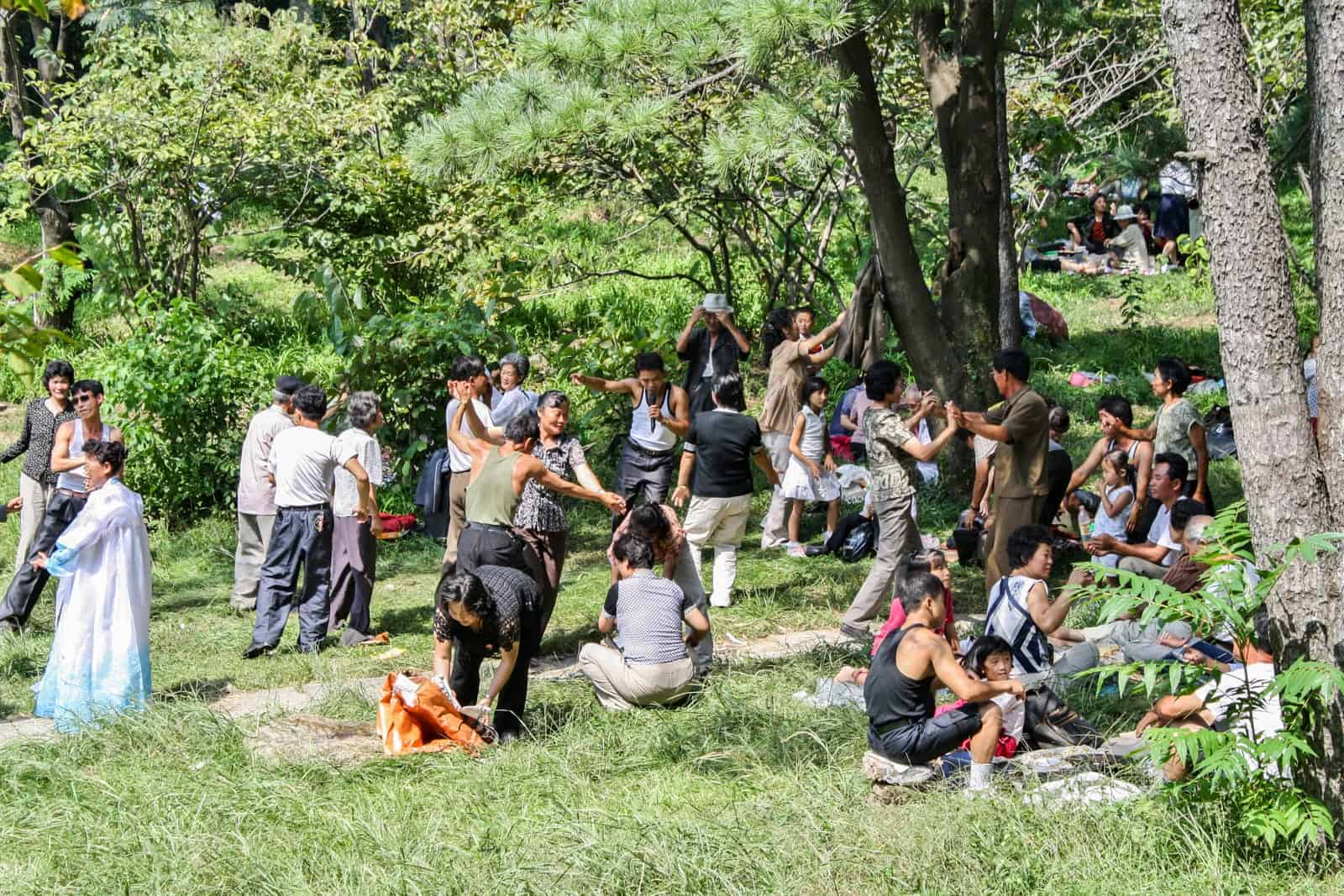
National Day in North Korea.
What Do You Get to See in North Korea?
The number one rule of travel to North Korea is that you will never see the real North Korea. Travelling to North Korea is in no way a relaxing holiday or a form of vacation. They want you to return having believed the PR presentation about development, happiness and loyalty.
Points of Hero Worship in North Korea
A trip to North Korea is not complete without the sites they want you to see – the showpieces of the regime and the points of Hero Worship – such as Kim Il Sung Square and the statue we had to bow to, the Tower of Juche Idea, the Founding Party Monument, the captured US spy ship USS Pueblo, Kim Il Sung’s native home.
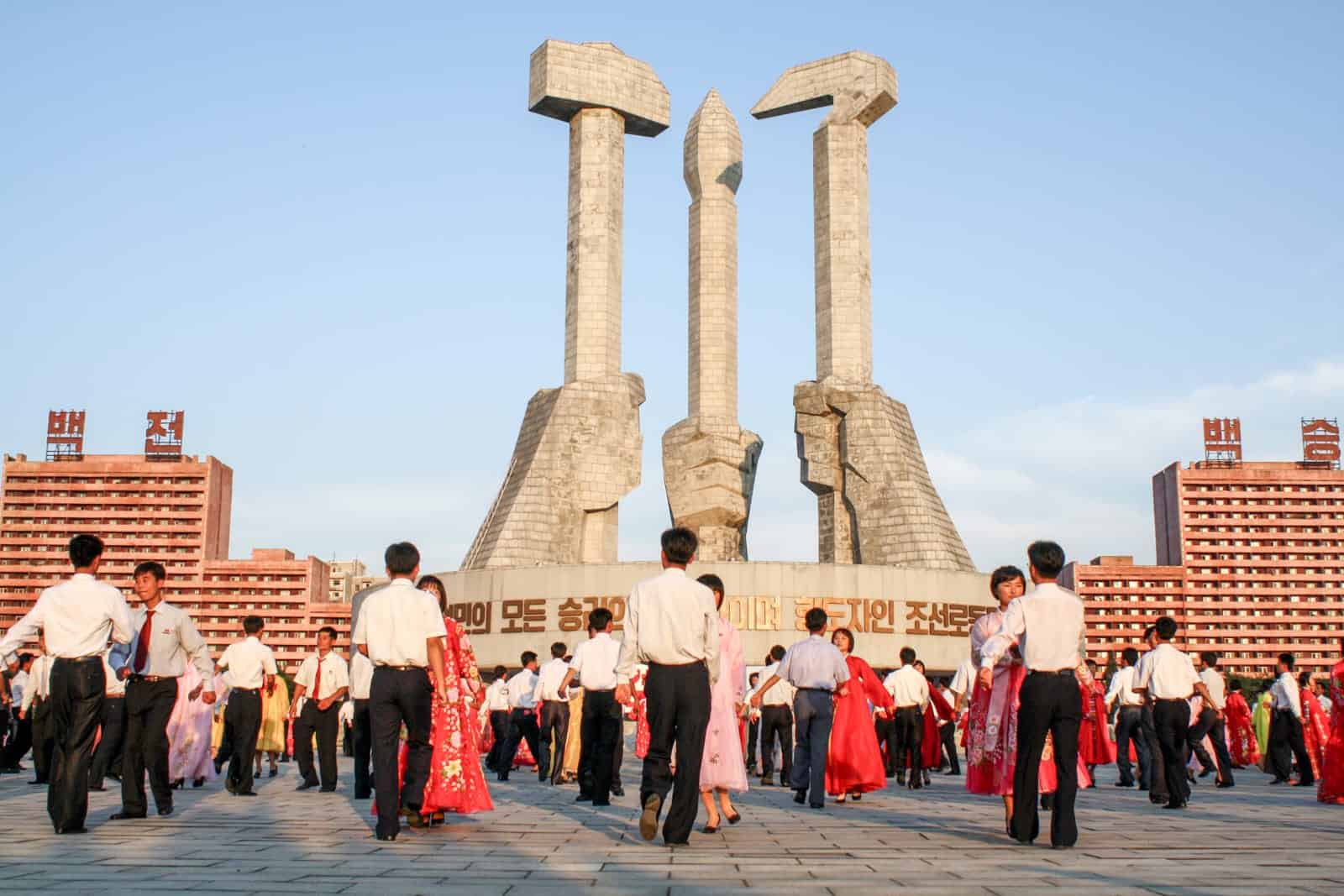
The Monument to Party Founding in Pyongyang.

Monuments and murals in North Korea.
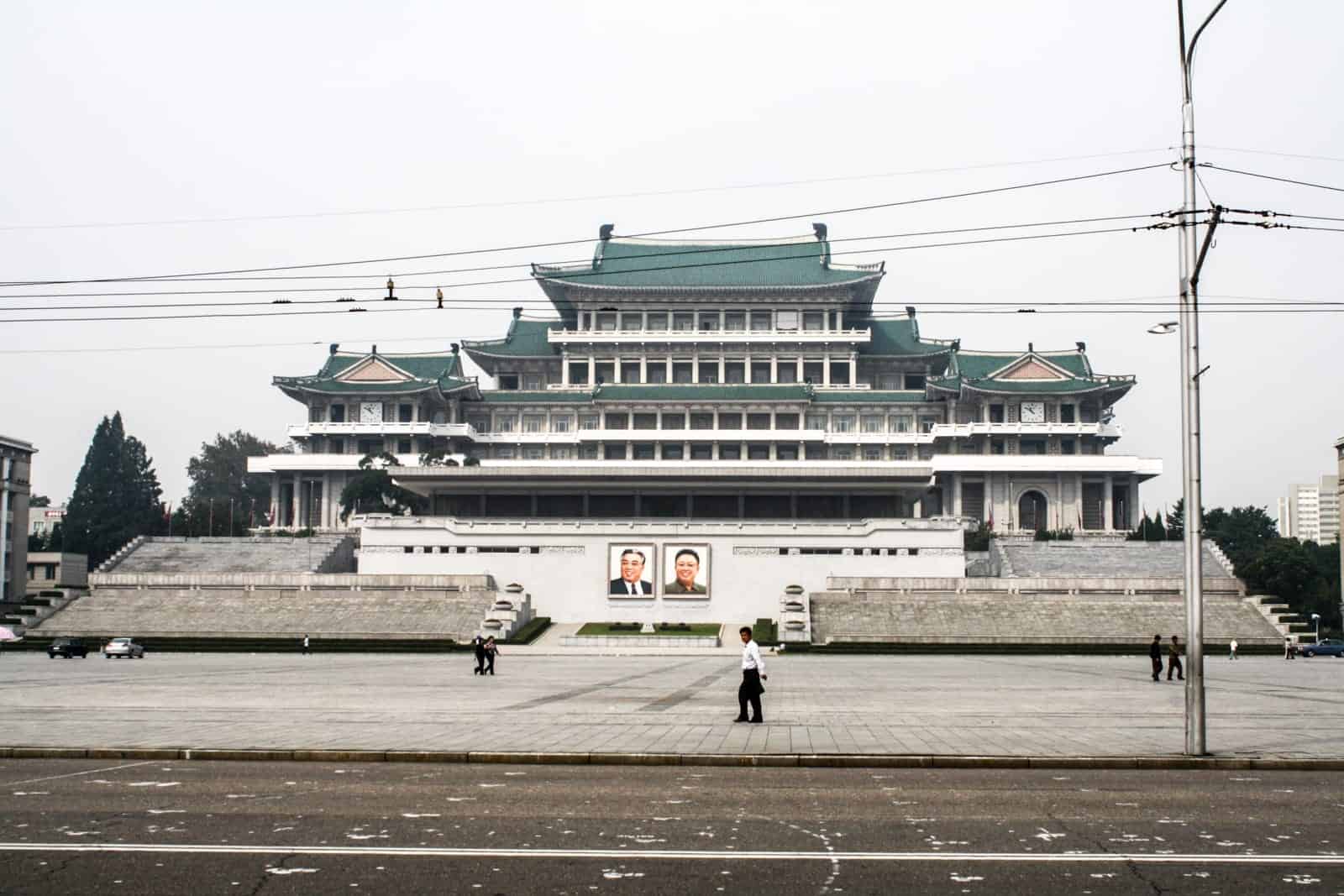
Pyongyang parade ground markings.
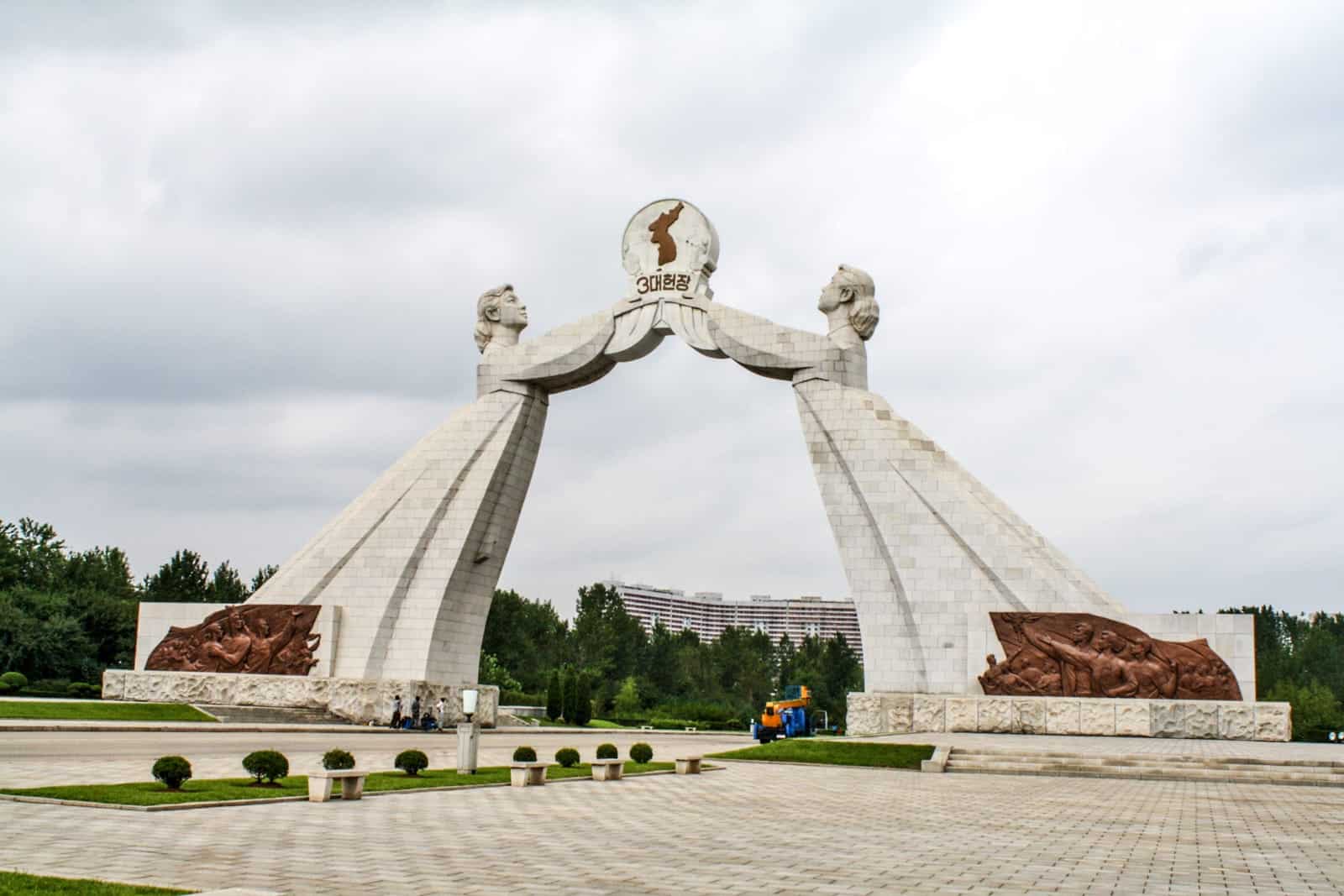
One of the many monuments in North Korea.
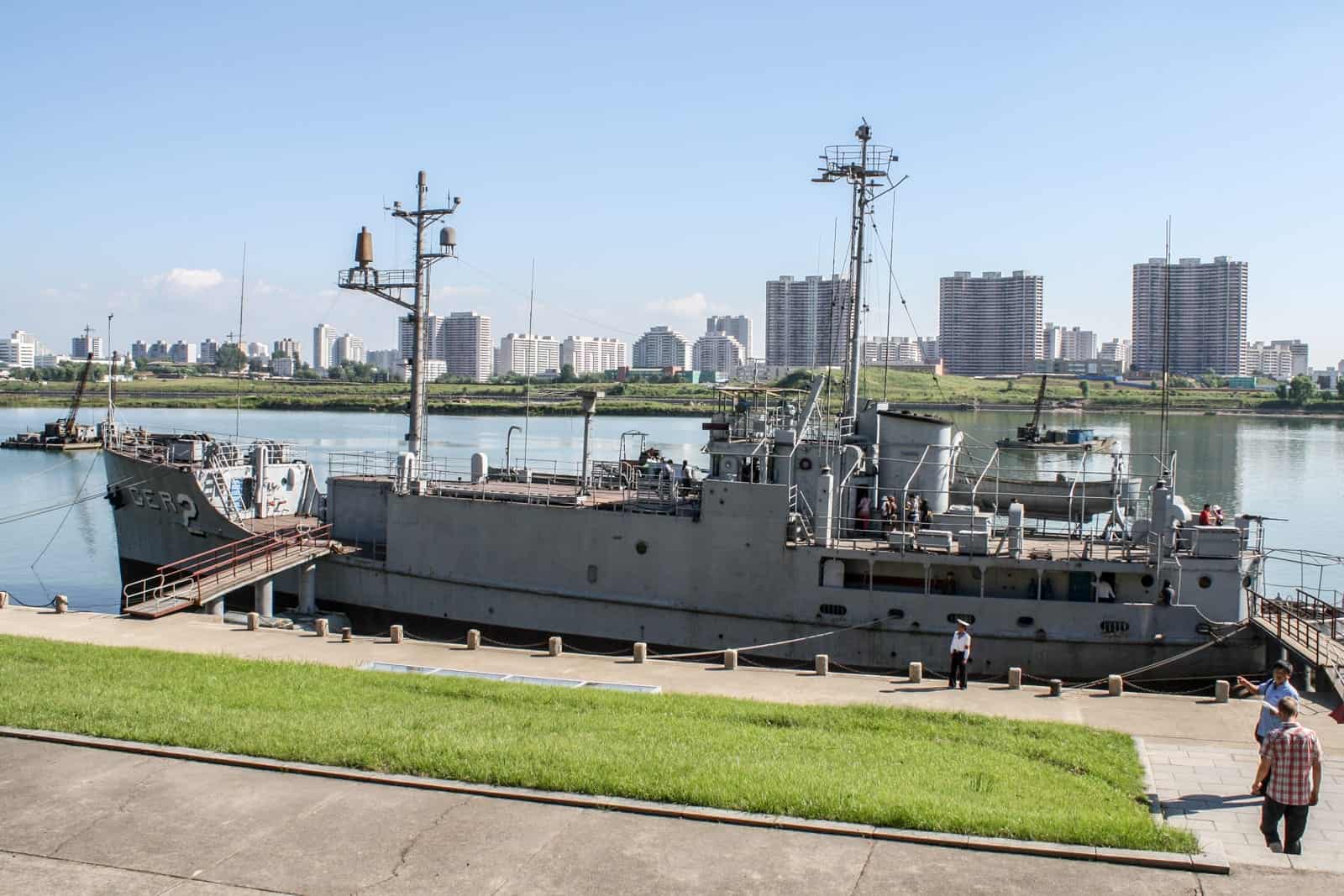
Captured ship US Pablo shown to tourists in Pyongyang.
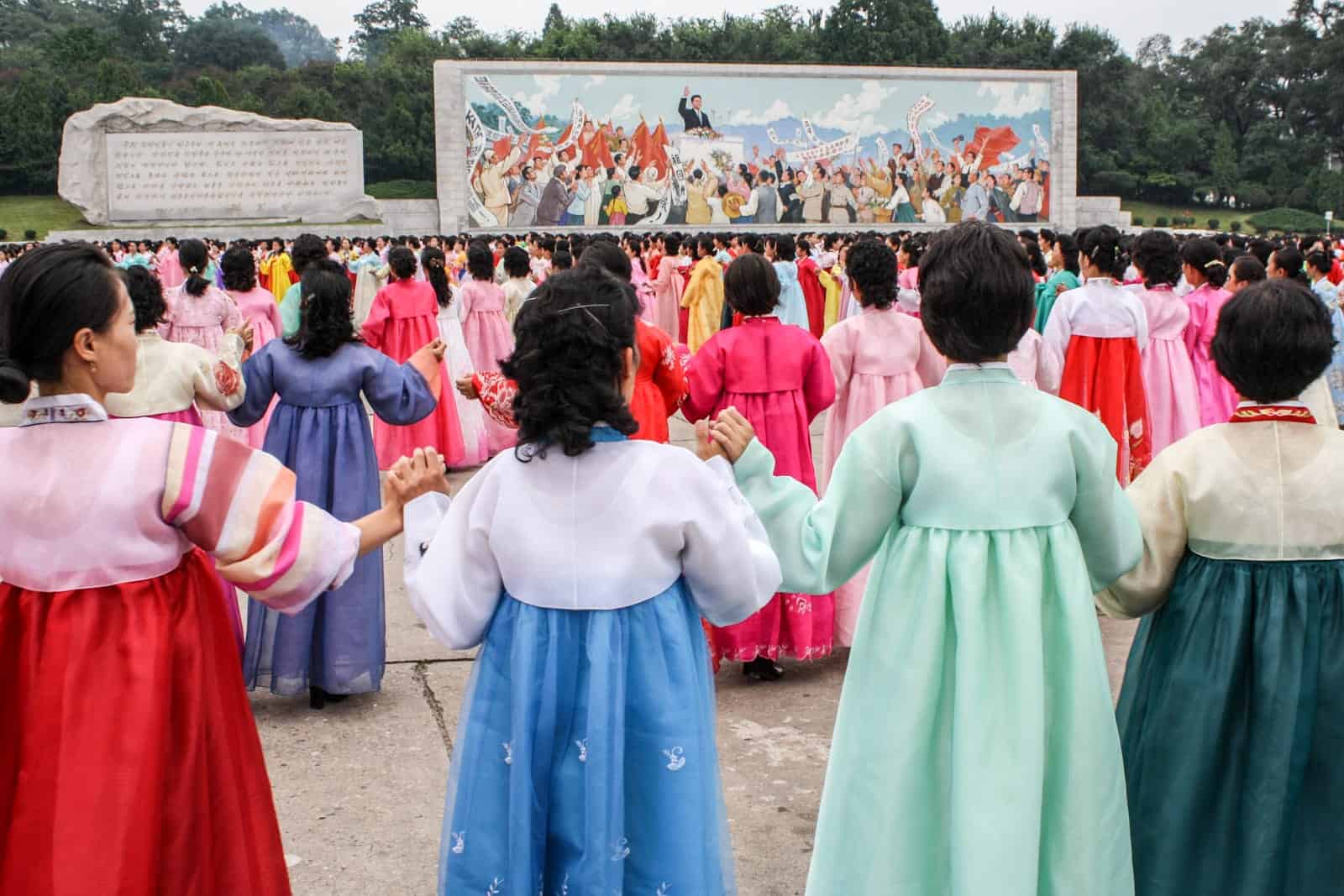
Korean traditional dress and dancing.
Places of Entertainment in North Korea
A fairground, a bowling alley, nights of karaoke. That’s also part of the itinerary and which you realise are places built for the elite locals and not just for western entertainment. Keeping the people happy and occupied – distraction keeps the ideological machine in motion.
Imposed Order and Fake Scenarios
The main downside to what you see is the imposed order and structure as well as the exaggerated explanation, yet this is what you expect before you come on the trip. Some things you visit, such as the farm collective, appear a little too set up with the people ‘placed’ there, which didn’t feel right or real at all. But you only had to look into the distance to get a better picture, without taking an actual photograph.
Propaganda literature and videos on a North Korea tour give an extremely one-sided argument to the history of the Korean War. It is frustrating, but you have to grin and bear it. Everything is built in what they call ‘chollima time’ such as their version of the Paris Arc de Triomphe, of which North Korea’s is bigger and took less time to build. “This would normally take five years to build, but we built it in three!”
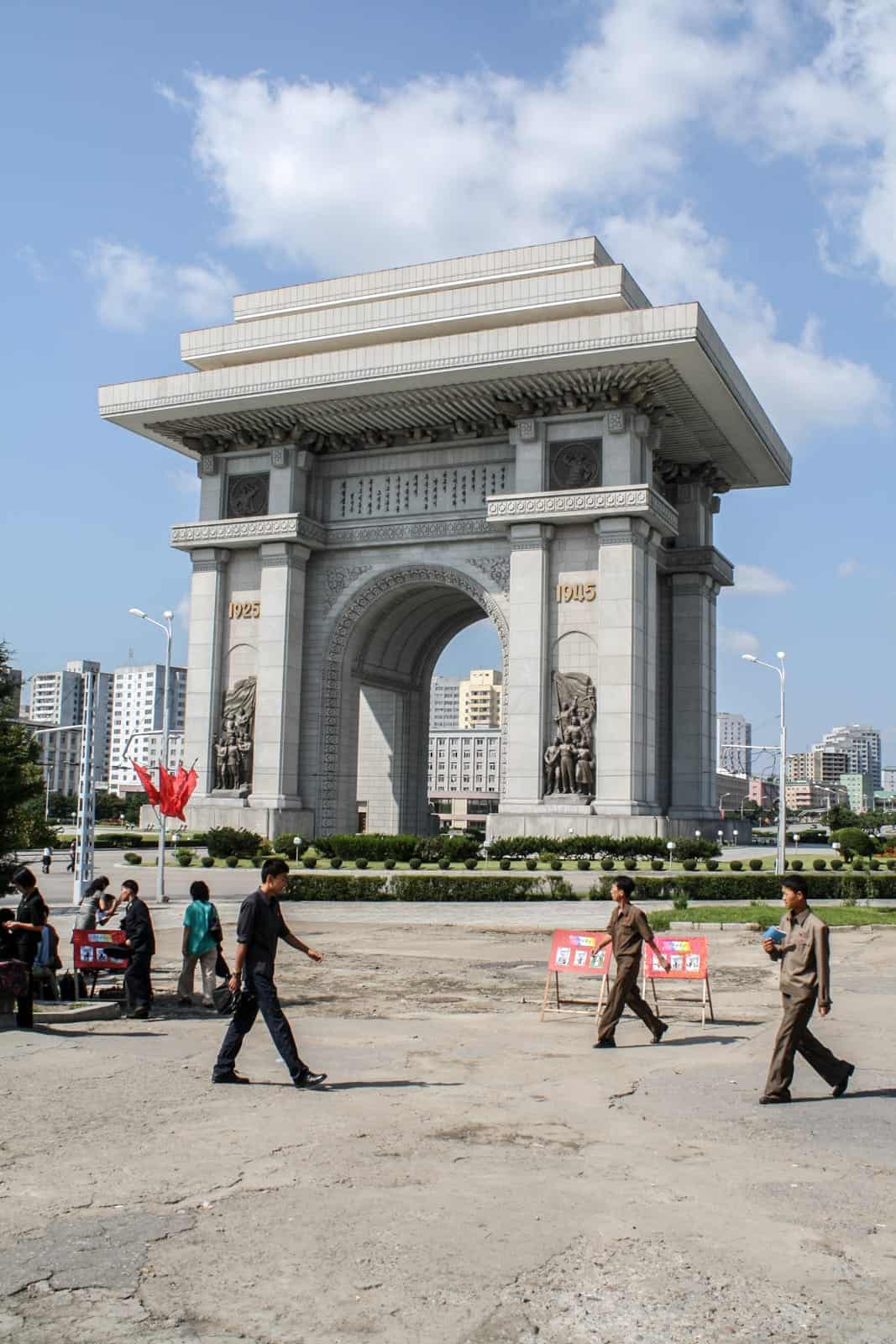
North Korea’s version of the Arc de Triomphe in Pyongyang.
Local guides gush about Kim Il Sung more than you would declare the love you feel for your parents – he is often referred to as ‘our father’ much like religious terminology. Films detailing milestones of the country such as the building of the West Sea Barrage dam are long, tedious and full of descriptions of the ‘revolutionary spirit’ behind its construction. Every place of high importance bears a plaque of when one or both of the Kims made a visit, alongside a giant painting of them.
This can become very tiring but does give solid insight into the way the minds of the people have been moulded and the lessons to be learnt from that.
A Visit to the DMZ from the North Korea Side
While tourists can easily visit the DMZ in South Korea, North Korea’s tourism doesn’t leave this off the agenda. This is your chance to see it from the other side and, of course, hear the story from their perspective.
You get to sit in the same room, converse over the negotiation table (which you are not allowed to sit at when you visit from the South Korea side) and see the North Korean guards on duty at the borderline.
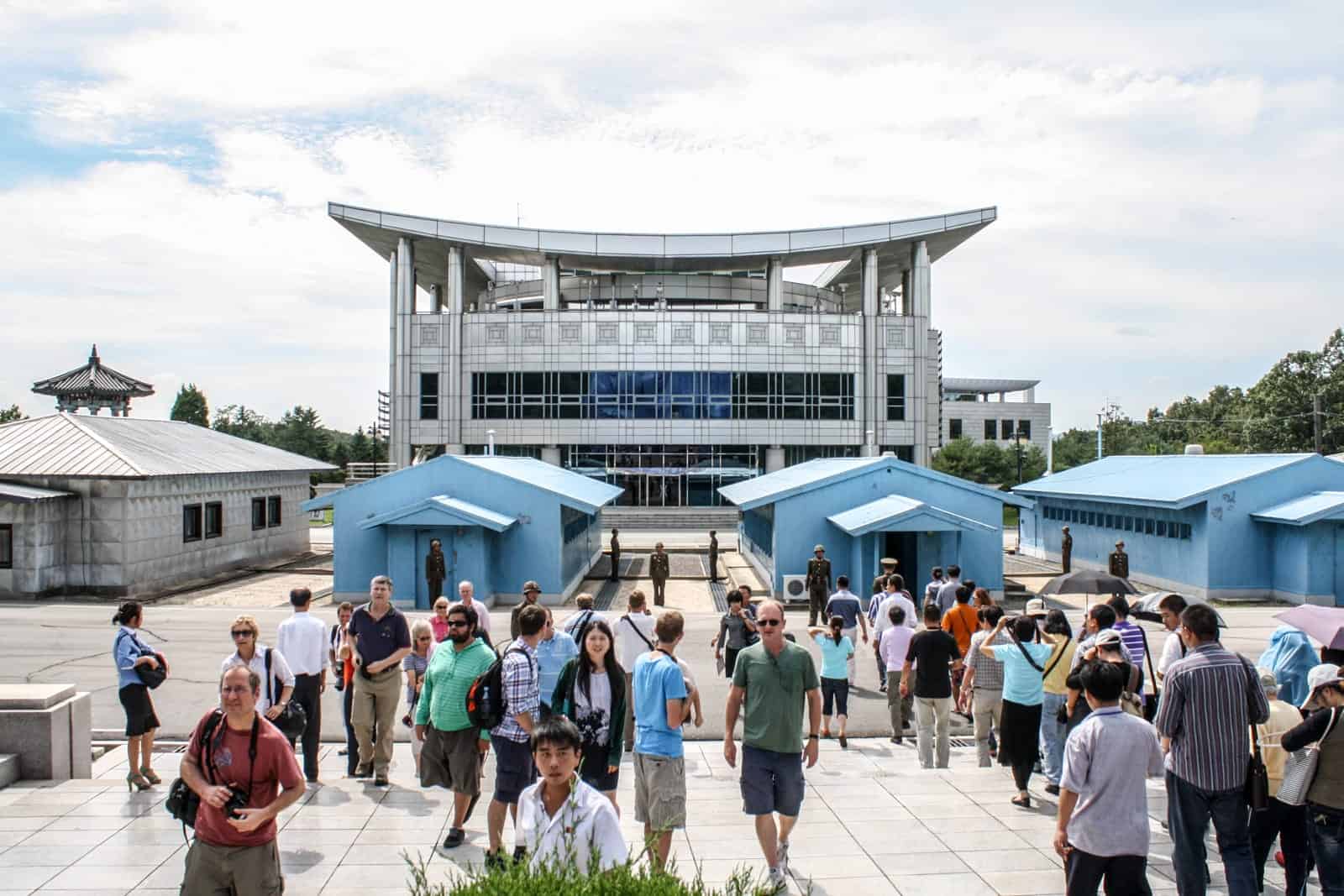
Visiting the DMZ on the North Korea side on a guided tour.
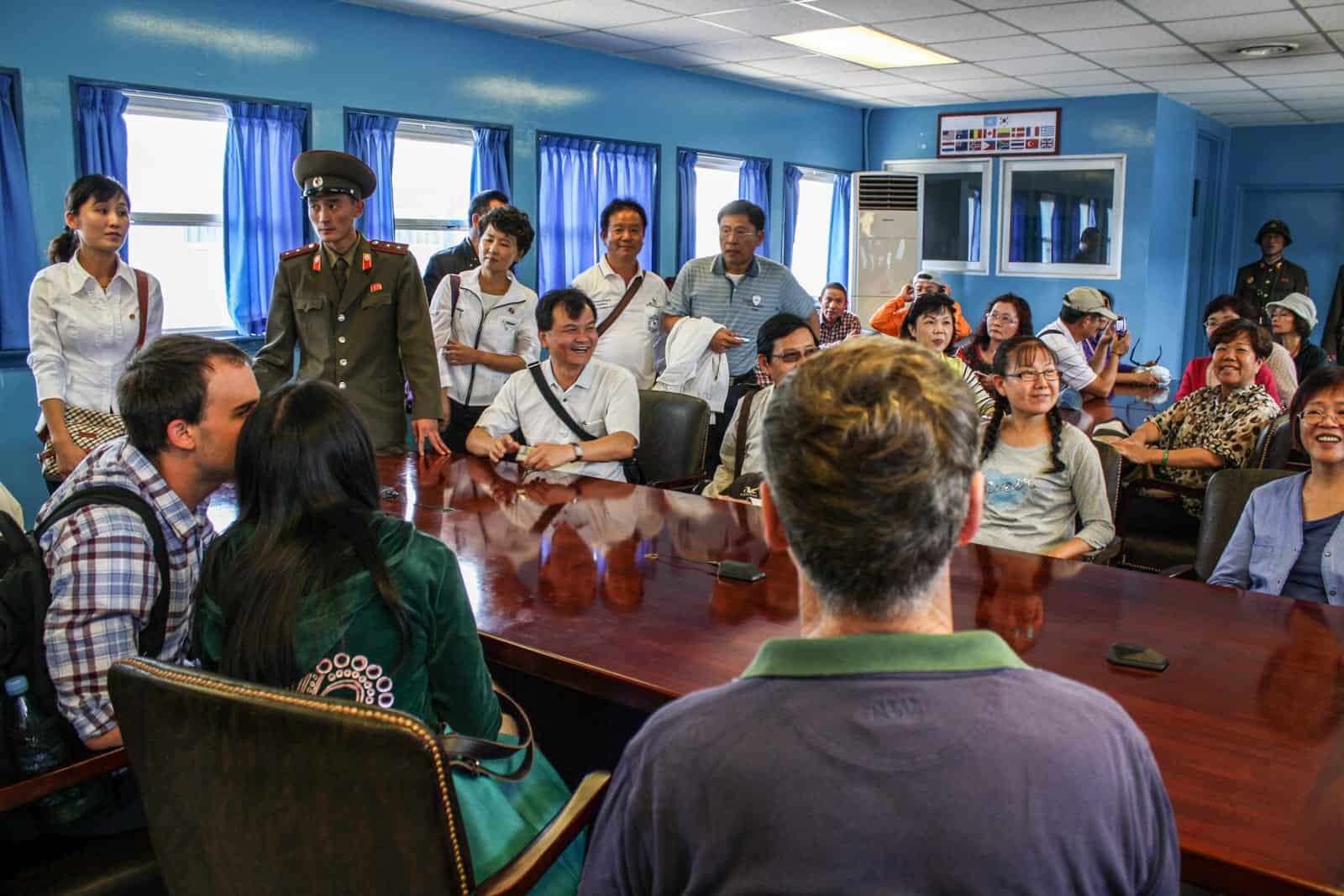
Around the table at the DMZ meeting room on the North Korea side.
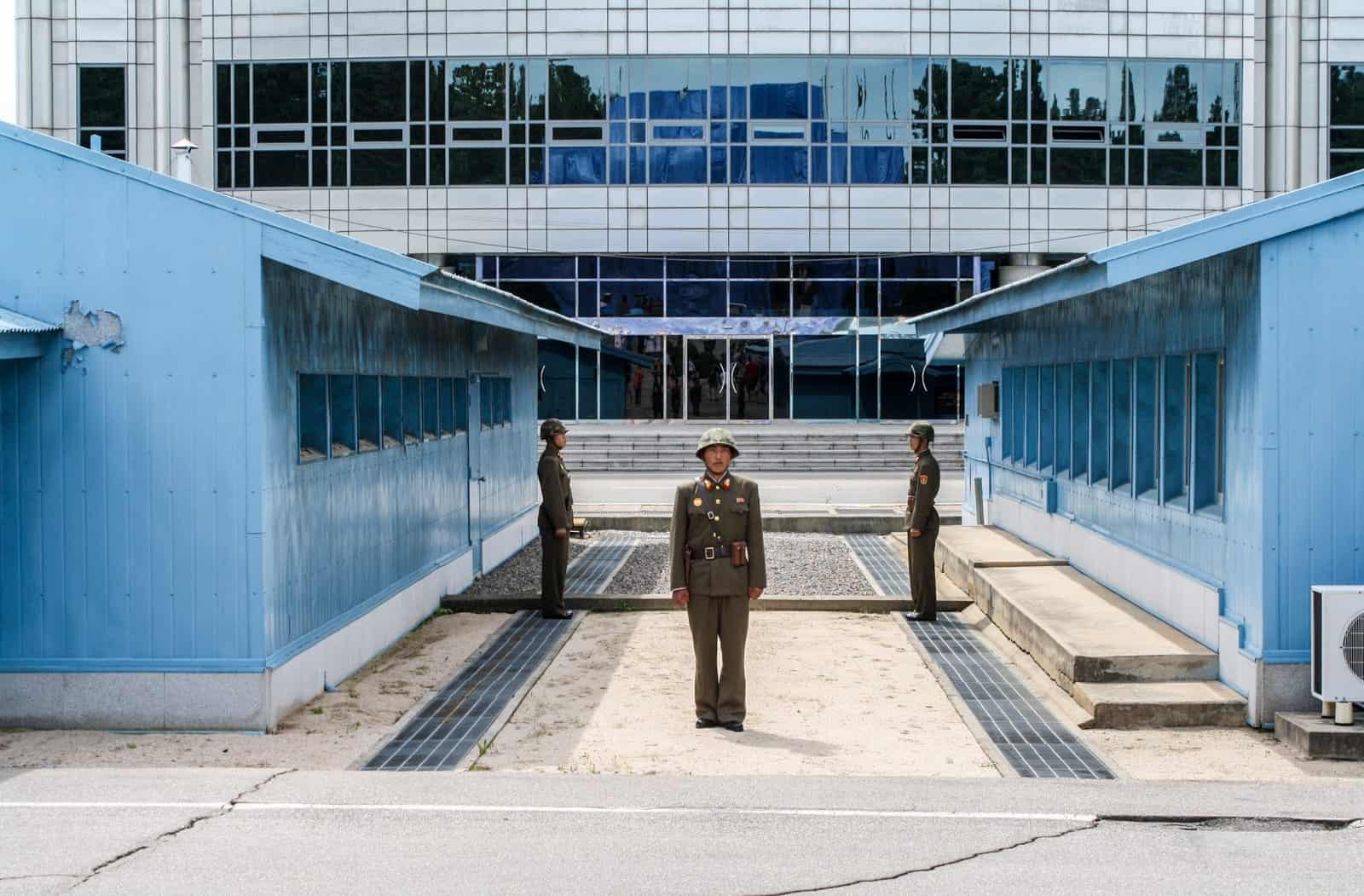
North Korean guards at the DMZ border line.
After that, you will get to look through Binoculars out into the DMZ ‘No Man’s Land’ area in-between the two country borders, where you are informed North Korean guards keep constant watch.
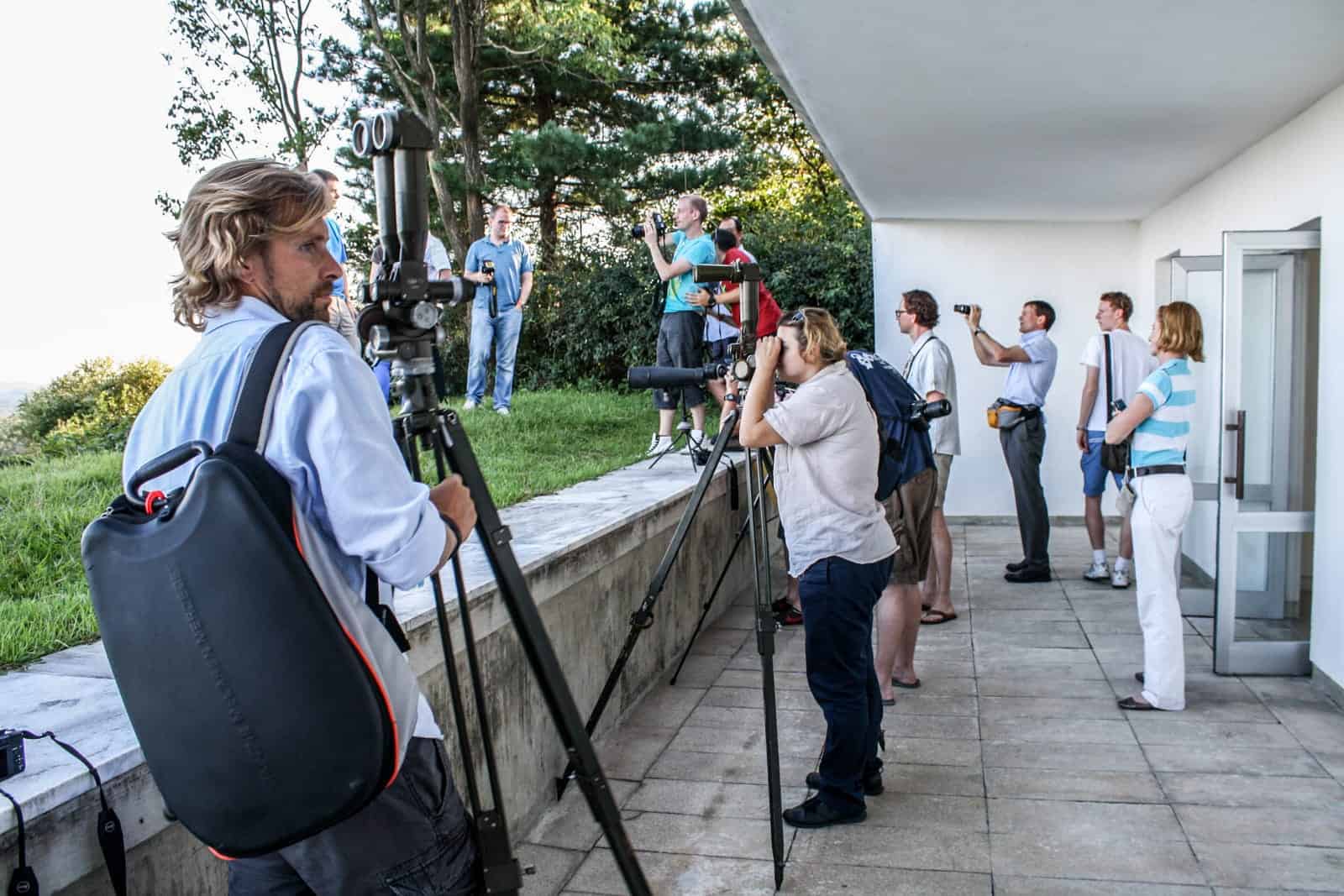
Looking out into the DMZ No Mans Land from North Korea.
READ MORE: Visiting the DMZ in North and South Korea – The Story of Both Sides
Riding the Pyongyang Metro
One of the deepest metro systems in the world, you get to go 110 metres underground to ride the Pyongyang metro. Adorned in intricate mosaic tiled propaganda images and bronze and with revolutionary themed names like ‘Comrade’, ‘Glory’ and ‘Reunification’, North Korea’s subway is quite the experience.
This is a stop included on your organised tour since North Korea is both proud (of those stations on show) yet secretive and guarded since you can ride only five of the 16 stops. Of course, you embark and disembark at the grandest station of them all – Prosperity.
Hundreds of people can be seen making their way to and from work and home, on a ticket that costs 5 Won (less than one US cent). I have seen images of all 16 stations in use and apparently, you can ride all of them – you just don’t on a tour as it would take too long. But in reality, we will never know if the entire metro system is in constant working order and for whom such a service is for.
I’m fascinated by metro systems all over the world and the Pyongyang subway is a highlight for the curious-minded. I would love to ride them all since it is said each station exists as a timeline and story flow of North Korea’s history.
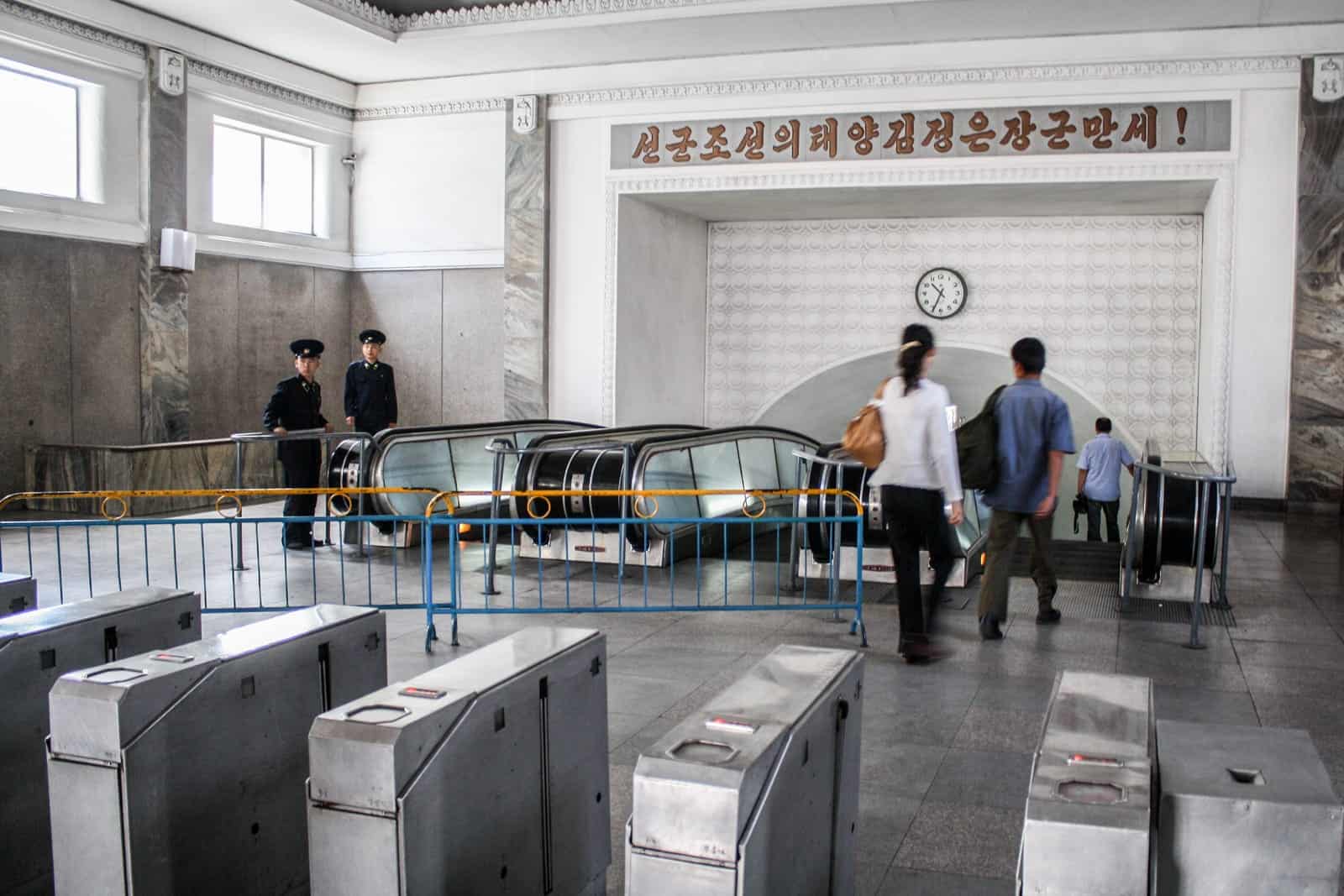
The part of the metro in Pyongyang open to tourists.
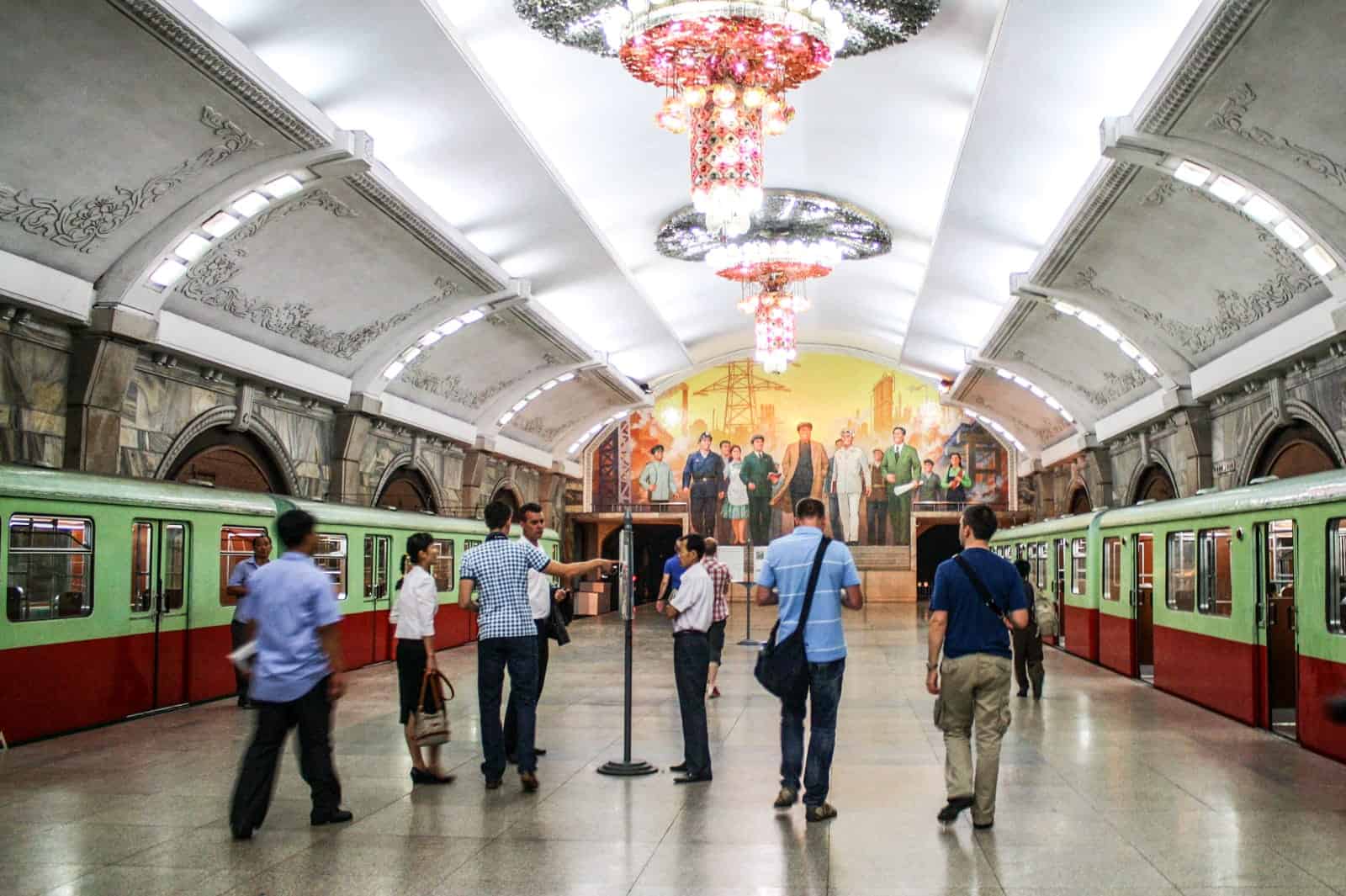
Inside the decorated Pyongyang metro station.

Newspaper on the platform of the Pyongyang metro subway platform.
Watching the Arirang Mass Games in North Korea
When you sign up for your North Korea tour you will be asked if you would like to purchase a ticket to the famous Arirang Mass Games spectacle at the Rungrado May Day Stadium, also known as the Arirang Festival. It is deemed a highlight and THE thing to see in Pyongyang, There are various tickets for different seating plans, but for the majority of tourists this feat of athleticism and showmanship of gymnastics is a highlight.
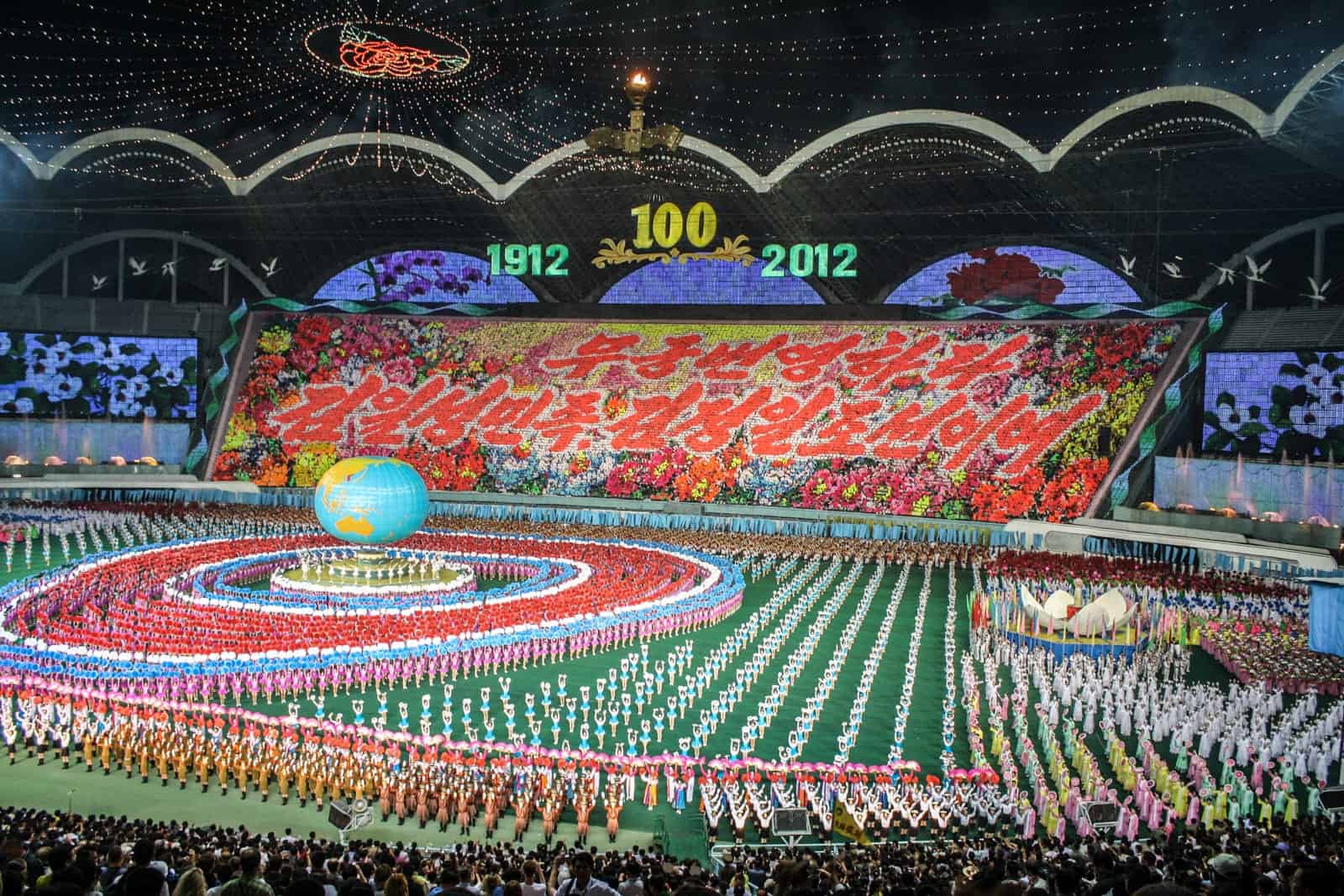
The Mass Games in North Korea.
While no show on earth will ever compare to that of the Mass Games in North Korea – a spectacle so incredible and full of athletic prowess that it blows your mind – it was also very uncomfortable to watch.
At the back of your mind weighs the reality of the extreme training of the participants, who live within a gruelling and dominant regime where the Mass Games is a part of the societal showcase. You can imagine the pain and endurance to be perfect, and exactly what would happen if someone messed up. No one puts a foot wrong during the performance.
As a communist state, North Korean flags and red symbols appear heavily throughout. The huge picture in the background? That’s school kids trained all year to make images from pieces of coloured cards for hours on end at this show.
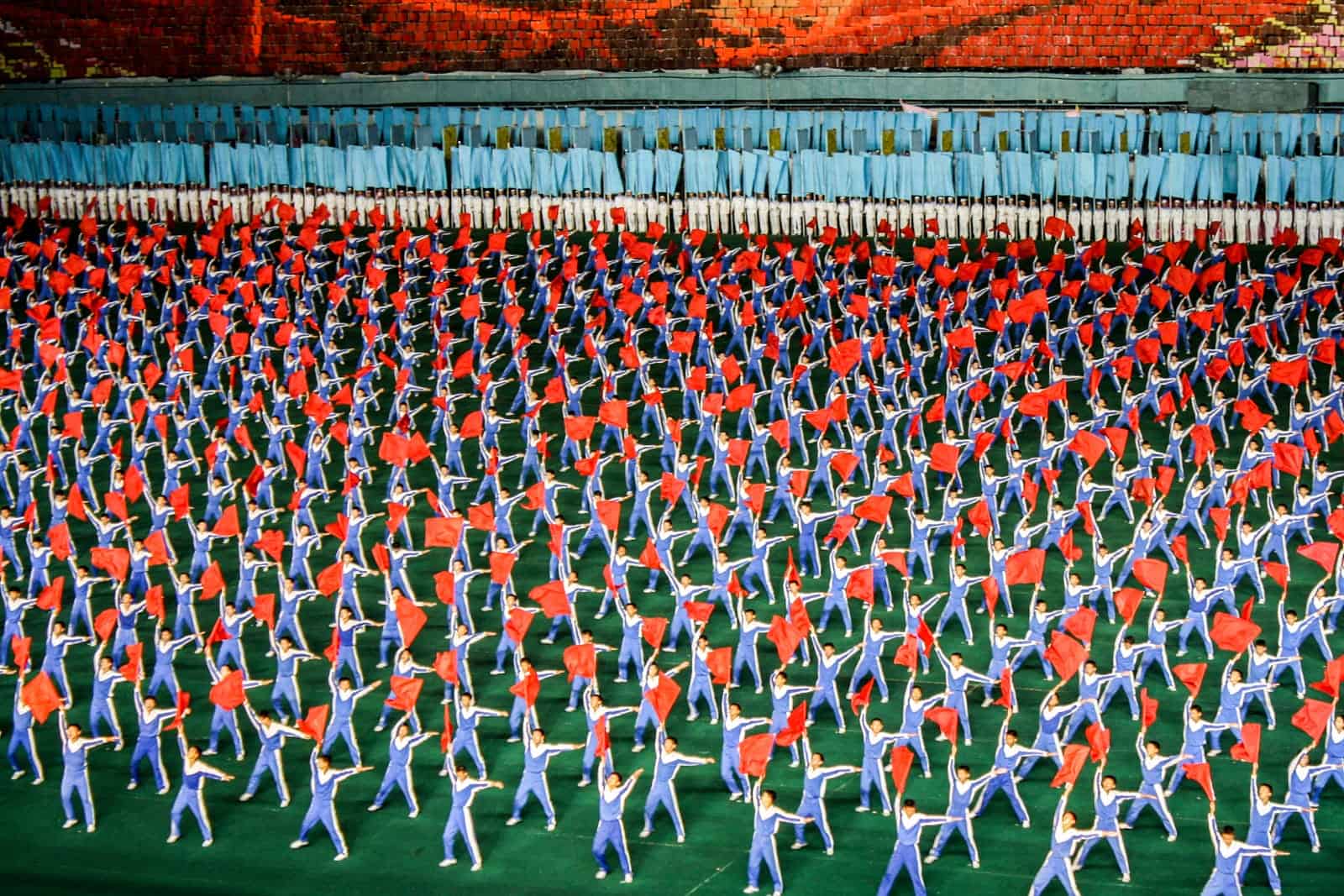
Watching the Arirang Mass Games in North Korea.

The hundreds of performers at the Arirang Mass Games.
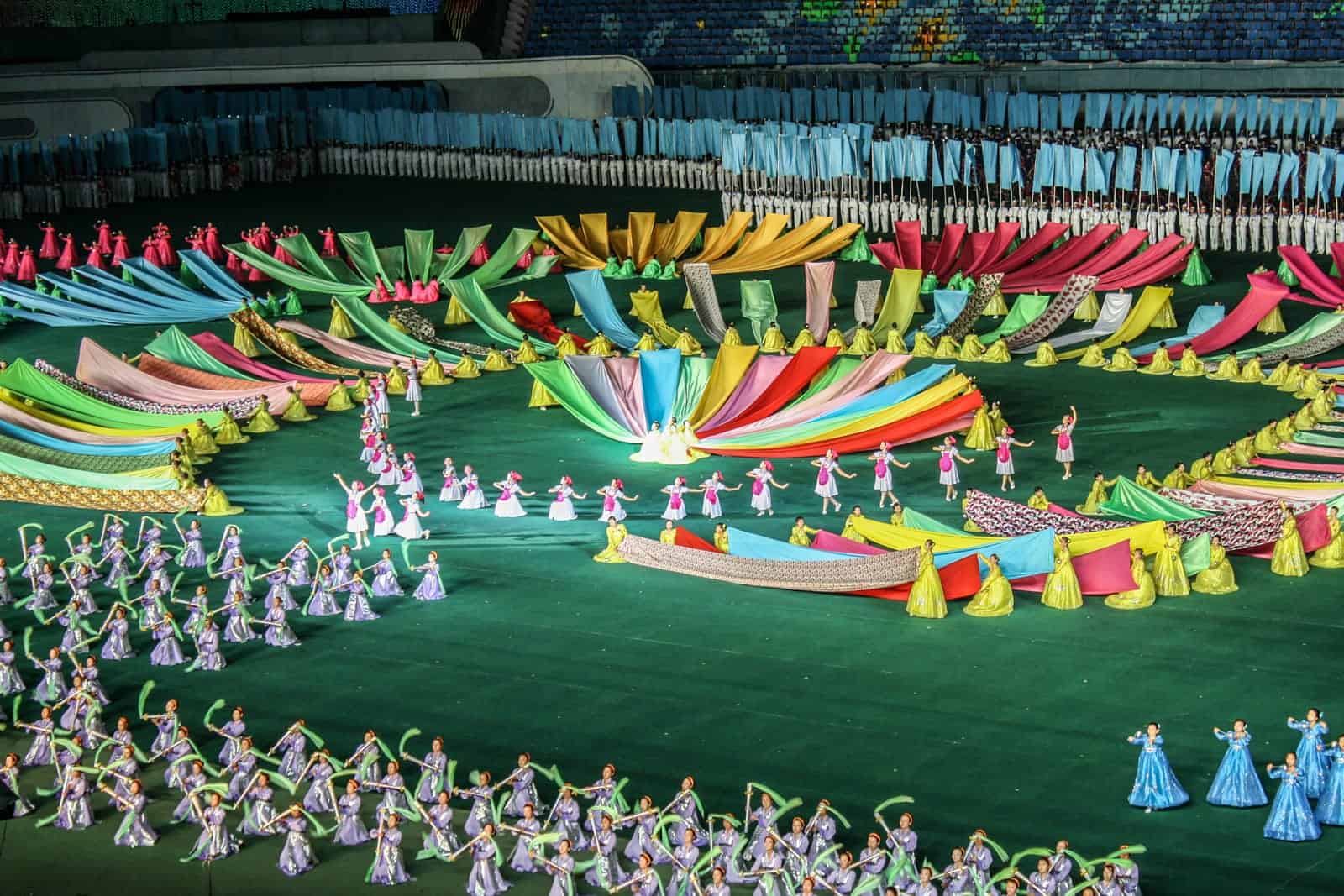
The Grand Mass Gymnastics and Artistic Performance Arirang.
Be Open-Minded When You Travel Here
While places of communist past have or are slowly moving on, becoming ‘socialist’ and slightly more progressive, North Korea lags behind by still keeping an ultimate grip on its people, yet struggling with the realisation that it needs to develop, trade and open up with the rest of the world in order to sustain itself in the modern age.
A country striking fear into the heart of its people is the only way it maintains control. This is something my generation, in particular, doesn’t understand as many of us have never had to live in a country in serious conflict with another. Whilst we would all love to see a united Korea, it wouldn’t be that easy.
Think of the differences between East and West Berliners when the wall came down. Two ideologies and different ways of life collided; two economic and education systems trying to integrate. I couldn’t imagine this would be an easy process of bringing immediate peace, but hopefully, I will see some movement towards this in my lifetime.
In tourism’s infancy, around 1,500 tourists visit North Korea annually. Today, that number is more in the regions of hundreds of thousands, but mainly from the Chinese market in comparison to the smaller numbers of western tourists going to the DPRK. Still, that’s thousands more than we ever thought possible.
From what we were told from the Koryo Tours representative with us, the more time goes by, the more tourists are allowed to see and do – a two-way trust process that slowly grows, where we can show the North Koreans a positive side to the Western world and its people and where we can try to understand them. A hope that it somehow paves the way for openness.
Maybe one day the people will harness the power for change or the ideological system will change.
Only then can we be friends without restriction.
The Importance of Travelling to South Korea
It was important for me to gain a wider perspective on the culture and history of the Koreas and the conflict, and so a few months later I travelled to South Korea for three weeks. I was able to see some core sights and gain a better understanding of just how different life is on the other, more accessible side of this heavily tested border.


Chris Padley says
In his TV programme made of his visit to N.K. Michael Palin visited a park on National Day too. A comparison between this, as seen in the TV programme, and your description of your own experience is interesting.
Paul Cosgrave says
Becki: Great Article. You are a brave person to have gone to North Korea. As an American I will not be going anytime soon. I agree with your comments that travel is so important to help us understand the people and their motivations who have grown up in different cultures than ourselves. I realized this in a recent trip through Vietnam and Cambodia where the culture is clearly not as different from our western background as what you experienced in North Korea, but nevertheless very different from what I had expected. The one thing I have learned from my travel is that people around the world are much more similar than they are different.
Eric says
I traveled to North Korea in 2007. Americans were not allowed to visit for a long time but when they allowed a few American tour groups in that year I jumped at the chance
Everything in this rings true to me. I am still conflicted as to whether giving money to the regime was a good thing
However there were several moments when I had a brief but human chat or laugh with one of our guides. Talking about family and universal stuff. I hope that made a tiny bit of difference in understanding
Becki says
It’s a real conflict mentally and morally. Although North Korea is up there as one of the worst, we sadly give our money to many regimes when travelling. But I firmly believe that those chats on universal stuff are a way of paving the way to openness, truth and understanding.
Aaron Galan says
I would love to go to North Korea just to have another perspective of what it is shown on TV. Maybe give a chance to this country, because it’s easy to say that a country is bad for its bad reputation on TV. And I know this because sometimes other countries think that Mexico is just as bad as a Warzone.
Apart from that I would like to see if it’s true that everything is as Asymmetrical as everyone says. I would also like to visit the DMZ from both perspectives to compare each sides of the stories
Victoria says
I know you wrote this post a couple of years ago, but it’s as relevant today as it was then.
The question of whether to visit North Korea or not is a most controversial one, which I’m not fit to answer, as it’s not only a personal choice, but a political one too.
Either way, I thought your article was well written and is to be applauded.
Nice one Becki!
John says
I have always looked for some balanced account of North Korean life and the North Korean reality. I hate being fed by one-sided propogandists, be they from the West or from the North Korea itself . I found for the first time today some kind of neutral account. Thank you so much for posting. While many Westerners vehemently criticize or even hate North Korea, I think they are still better than a lot of other countries infected with corruption, terrorism, wars and killings. Why should we bother about the ideologies that are different from ours?
Becki says
I don’t think North Korea is better at all. I just think we have a duty, through travel, to show local people the truth in whatever way we can – despite inevitably giving money to the government by visiting. Never do I say that this country is good or better, but that there is a balanced way to approach what’s happening there without tarring innocent people with the same brush as their leaders. Or using what’s happening there for entertainment. I, for one, hope it changes as soon as possible.
Jack says
A very thoughtful piece of writing. I too visited the DPRK (last year) and think about my trip a lot there. It seems you and I reached several similar conclusions. Good that there are wise, philosophical travellers like yourself!
JK says
Stumbled upon this, and it is probably the most balanced account.
I work in London at present but hail from India. Some of my closest ‘mates’ here are well educated English. In a lot of conversations, despite all their well intention some times even one article in any daily provides them a distorted view of a continent and a country. I can’t even imagine how inaccurate is the perception of people for a ‘closed’ country like North Korea.
Most of the news that we receive has undertone of putting things in the common accepted narrative, which makes it easier to sell and understand. I have studied here and working now but I have also lived for a large part of my life in India and therefore am able to understand the bias and inaccuracy commonly in the western narrative.
I am not suggesting North Korea is alright, but every country has their own pace of evolution and unless they are bothering you – we should leave them alone to fight it out among themselves. and sort their own destiny.
I think my comment is absolutely incoherent, but I will just let it be now 🙂
Becki says
I’m actually sad that the world stands by and watches North Korea as it is. People there are suffering terribly and I long to see some kind of revolution. I just think that now, tourism is one of the only in-roads for local people to get a glimpse into the fact that Westerners are not the evil they are portrayed to be, amongst other things. There’s room for progression there – just a huge shame the government will never allow it, only operating on a system which benefits an elite few.
Aldwin says
Totally agree. April 2012, we were on a 10 day trip with Koryo Tours there. And it’s so difficult to explain this to people. Why did you go there? Why? … Because to see and feel it myself. To make up my own mind. Indeed, they don’t know themselves, so I see them happy in their own world. Are we more happy? I think I hear more complaining day in day out, morning till evening, on every blog, on every article, … fake smiles, hypocricy, acting, … than what is happening in the daily life of a DPRK citizen. My biggest shock was reaching Dangdong by train in the evening, out of the DPRK, and suddenly all the advertisment attacking me. I was 10 days of my life not influenced by advertisment, just had to follow the guide without thinking. Both is tiring, … Thank you for the article.
Becki says
It was very difficult to deal with, especially when you think what happens there that we don’t see. I only hope that the small things I saw that were positive lead to change…eventually. I’m glad you found the post useful!
Sophie says
This is a great piece becki! It’s great to see an actual honest look into North Korea, not the propaganda journalism you usually see. Thanks for sharing! I’m actually keen to going to both North and South Korea on my Asia travels, thanks so much for a really insightful post! New to your work, but loving following your journey 🙂
Peter says
Really interesting post – often I wonder when and how countries like North Korea, Iran and Pakistan will (re)open to tourism and what will be found. Very envious of your experience!
Julie says
Wow, what a great post. So glad to have found it through a rt on Twitter! I studied abroad in South Korea in college and visited the DMZ which for me was a mind blowing experience considering the enormity of what it represented. And yet thanks to travelers like you, the world can see the other side-one free of biases and misrepresentations.
Caitlyn says
Great post about something we rarely hear! It’s funny, I went on a tour of the demilitarised zone (DMZ) between North and South Korea a few years ago, and was rolling my eyes at the lines we were fed by our guides; the South Koreans call their village on one side of the border ‘Freedom Village’ whilst the one on the other side is called ‘Propaganda Village’. Depends who’s telling you the story, hey.
Sarah says
I really enjoy your writing style and feel like you were on point with your experiences in S. Korea/ Seoul and the descriptions you provided seemed pretty accurate. My mom is Korean (from Daegu) and I’ve lived in Seoul on and off for the past 7 years or so. Along with speaking the language and having my family & friends all around, I love Korea because it is part of me and where my ancestors come from. I agree with you on a lot though & I probably wouldn’t even have much of an inclination to go in the first place (if I wasn’t part Korean) and to this day I don’t really recommend it to the typical traveler. . I’m glad you explored all Of the places you did though , props to sticking it out!
Now N. Korea on the other hand is a totally different story altogether. I wanted to like everything about what you posted …but my heart aches thinking about how many excited tourists sign up to go visit the DPRK. God only knows how the Kim regime spends the “tourism money” that curious ppl like yourself bring in. I guess I can’t really blame you all.. It’s intriguing and fascinating as well as unique to say the least. But with that being said, my husband happens to be one of “those defectors” who still bears the marks and physical scars from the aftermath of his unspeakable tortures. I cannot even begin to comprehend everything he has been through not do I try, My the point is, The less money or foreign support going in , the more likely the DPRK government can collapse. You mention “full facts” but honestly judging by the guided tour you were given , I doubt you got anything close to fact. I do think your documentation and descriptions from your travels are very impressive however I just wish people wouldn’t “flirt with idea” (as the women below stated )of traveling to North Korea whilst thousands are being oppressed, persecuted , and tortured on a daily basis. Beyond journalists and media (of whom i don’t necessarily approve of either) I just don’t see the point or justification in spending money on a trip that is so highly controlled and obviously scripted only to end up being pocketed by an evil dictator and his equally evil regime. At any rate, I still admire your travels and appreciate your insights. Hope I didn’t come off the wrong way, I just get really passionate when it comes to N Korea and their deplorable human rights crisis which many choose to ignore or look past.
Becki says
Hi Sarah. It doesn’t come across in the wrong way at all – I really appreciate your perspective and taking the time to write. You have a unique insight and it’s good to hear it.
Regarding North Korea, I don’t condone “flirting with the idea” either. I tell many people that it is not a holiday and nor it is cool to go there just to ‘country tick’ and pry. And I detest posts making it look like a circus and giving false claims like: “Things you didn’t know about North Korea” and listing all the things they have been duped by. The worst I saw was “North Koreans Like Ice Cream!” This needs to stop. And yes, there is no cloaking the humans rights issues, when we all know what happens.
I went because I have a deep passion for history and to find deeper meaning in what is happening today and also, as I say in my article, that I hope tourism (in the best sense it ‘could’ possibly be here) helps North Koreans see that outsiders / the Western world doesn’t dislike them or want to hurt them. Despite there not being any direct lines of communication, I had one or two moments where I felt this was communicated and where I knew that…they knew the truth. I have no respect for journalists who go there and come back and write false captions to photos and use things to heighten drama and make the people there seem like idiots, when really, they need help.
It’s a catch-22 on money to the government. In many countries our money goes to a terrible government or military stronghold. It would mean not travelling to many, many places if we boycotted a country because of that. Although in this case it harder as it’s not a case of: money to a bad government vs. being able to give to local people once you are in the country. That aspect is heartbreaking. On the other hand, as mentioned, I hope locals see that the outside world knows of their plight and that things start to slowly unravel internally. I’m waiting for the day when the people rise up, if they ever can… since nobody else is helping them.
What I would love your thoughts on is something that very much surprised me after going to South Korea, following my short time in the North. In that, people of the younger generation seem to have little care for what is happening in the North. They would mention economy and how it would be destroyed (I know culture on the South rests on working hard and keeping a ultra-strong workforce and economy) and that once the 2,000 or so direct bloodlines /relatives essentially ‘die out’, then the South will cease to care. Also that reunification is just not something they ever want to see happen. My response was “But they are still your people. They are still Korean!” I know this doesn’t account for every person (and that there are groups in South Korea fighting for rights and change in the North), but this mindset both shocked and interested me.
Leeann says
Hi Becki, first of all thank you for your reply. I really appreciate your willingness to learn and ability to pick up on things others might not: you know, when I first moved to S.Korea I wasn’t exactly concerned either and there are various thoughts on why. Not that it is an excuse but there are definitely some plausible reasons. if you look back on the history of this war torn peninsula, once the border was set and the two countries were officially devided, they each were focused on doing better than the other. For a while, the north was actually significantly more advanced and well off than the South all the up until the 70s (I think) When the Soviet pulled out. From that point the South became a miracle Country and its achievements and growth sky rocketed. They became more like strangers than brothers and sisters. Unfortunately much of the government and majority of the population were so focused on that growth and development and truly was consumed with it.. the more they succeeded the less they had time to worry about or focus on their neighbors above. Yes many were divided and families were separated but as much effort as those helpless few tried to put forth to bring about change, there just wasn’t enough support or power around them for anything to actually be solved. The problems are just too many. There were always groups and organizations that existed to help with the various North Korean related problems but ultimately most of the s.korean society became too caught up with themselves and too concerned about the here and now of their lives. Some felt hopeless and gave up on family left in the North while others simply felt more hurt and pain to even think about it and just moved on, the more time passes the more distance there is between generations and relatives who eventually pass away from old age or illness. The young generation now is encouraged to focus on national pride and prosperity as well as self. Luckily I’ve met students and activists who are trying to bring about more change. There is stil hope but there’s no easy answer. Nowadays there are s Korean variety shows featuring the defectors and refugees from the North and slightly more attention given to the Those who are trying to assimilate but there’s still so much to be done. I’m blessed to do what I can with my husbands private projects but I still question if it’s enough myself. I try to do what I can and make it known to those around me that it’s a problem. The indifference, the ignorance., the lack of empathy.. It’s a process though. Nothing happens overnight . Wow this was way longer than I had intended for it to be lol sry. Also I’m typing on my cell so plz just disregard me errors! If you have any other questions feel free to ask. I appreciate when “outsiders” show any type of concern or interest. Oh and by the way if you don’t mind, I would like to invite you to sign my husbands petition for his most recent campaign to meet his father who was used as a propaganda puppet & is still stuck in the north. Every signature counts ! ^^ ps my middle name is Leeann. (I used my middle name on my first post)